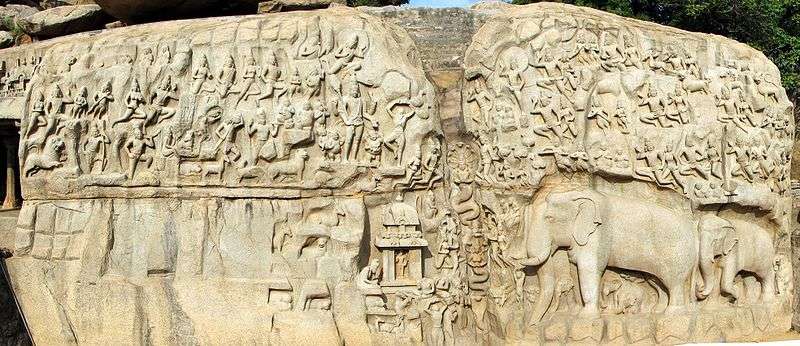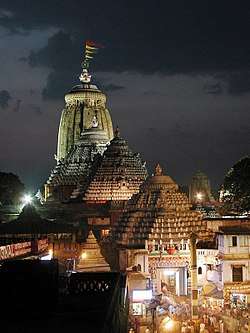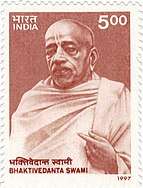History of Hinduism
History of Hinduism denotes a wide variety of related religious traditions native to the Indian subcontinent.[1] Its history overlaps or coincides with the development of religion in the Indian subcontinent since the Iron Age, with some of its traditions tracing back to prehistoric religions such as those of the Bronze Age Indus Valley Civilization. It has thus been called the "oldest religion" in the world.[note 1] Scholars regard Hinduism as a synthesis[11][12][13] of various Indian cultures and traditions,[12][14][11] with diverse roots[15] and no single founder.[16][note 2]
The history of Hinduism is often divided into periods of development. The first period is the pre-Vedic period, which includes the Indus Valley Civilization and local pre-historic religions, ending at about 1750 BCE. This period was followed in northern India by the Vedic period, which saw the introduction of the historical Vedic religion with the Indo-Aryan migrations, starting somewhere between 1900 BCE to 1400 BCE.[22][note 3] The subsequent period, between 800 BCE and 200 BCE, is "a turning point between the Vedic religion and Hindu religions",[25] and a formative period for Hinduism, Jainism and Buddhism. The Epic and Early Puranic period, from c. 200 BCE to 500 CE, saw the classical "Golden Age" of Hinduism (c. 320-650 CE), which coincides with the Gupta Empire. In this period the six branches of Hindu philosophy evolved, namely Samkhya, Yoga, Nyaya, Vaisheshika, Mīmāṃsā, and Vedanta. Monotheistic sects like Shaivism and Vaishnavism developed during this same period through the Bhakti movement. The period from roughly 650 to 1100 CE forms the late Classical period[26] or early Middle Ages, in which classical Puranic Hinduism is established, and Adi Shankara's influential consolidation of Advaita Vedanta.
Hinduism under both Hindu and Islamic rulers from c. 1200 to 1750 CE,[27][28] saw the increasing prominence of the Bhakti movement, which remains influential today. The colonial period saw the emergence of various Hindu reform movements partly inspired by western movements, such as Unitarianism and Theosophy. The Partition of India in 1947 was along religious lines, with the Republic of India emerging with a Hindu majority. During the 20th century, due to the Indian diaspora, Hindu minorities have formed in all continents, with the largest communities in absolute numbers in the United States and the United Kingdom.
Roots of Hinduism
While the Puranic chronology presents a genealogy of thousands of years, scholars regard Hinduism as a fusion[11][note 4] or synthesis[12][note 5] of various Indian cultures and traditions.[12][note 6] Among its roots are the historical Vedic religion,[29][14] itself already the product of "a composite of the Indo-Aryan and Harappan cultures and civilizations",[30][note 7] which evolved into the Brahmanical religion and ideology of the Kuru Kingdom of Iron Age northern India; but also the Sramana[21] or renouncer traditions[14] of northeast India,[21] and mesolithic[31] and neolithic[32] cultures of India, such as the religions of the Indus Valley Civilisation,[33] Dravidian traditions,[34] and the local traditions[14] and tribal religions.[35]
This Hindu synthesis emerged after the Vedic period, between 500[12]-200[36] BCE and c. 300 CE,[12] in the period of the Second Urbanisation and the early classical period of Hinduism, when the Epics and the first Puranas were composed.[12][36] This Brahmanical synthesis incorporated śramaṇic[36][37] and Buddhist influences[36][38] and the emerging bhakti tradition into the Brahmanical fold via the smriti literature.[39][36] This synthesis emerged under the pressure of the success of Buddhism and Jainism.[40] During the Gupta reign the first Puranas were written,[41][note 8] which were used to disseminate "mainstream religious ideology amongst pre-literate and tribal groups undergoing acculturation."[41] The resulting Puranic Hinduism differed markedly from the earlier Brahmanism of the Dharmaśāstras and the smritis.[41][note 9] Hinduism co-existed for several centuries with Buddhism,[42] to finally gain the upper hand at all levels in the 8th century.[43][web 1][note 10]
From northern India this "Hindu synthesis", and its societal divisions, spread to southern India and parts of Southeast Asia, as courts and rulers adopted the Brahmanical culture.[44][note 11][note 12][note 13] It was aided by the settlement of Brahmins on land granted by local rulers,[45][46] the incorporation and assimilation of popular non-Vedic gods,[web 2][47][note 14] and the process of Sanskritization, in which "people from many strata of society throughout the subcontinent tended to adapt their religious and social life to Brahmanic norms".[web 2][note 15][48] This process of assimilation explains the wide diversity of local cultures in India "half shrouded in a taddered cloak of conceptual unity."[49]
According to Eliot Deutsch, brahmins played an essential role in the development of this synthesis. They were bilingual and bicultural, speaking both their local language, and popular Sanskrit, which transcended regional differences in culture and language. They were able to "translate the mainstream of the large culture in terms of the village and the culture of the village in terms of the mainstream," thereby integrating the local culture into a larger whole.[50] While vaidikas and, to a lesser degree, smartas, remained faithfull to the traditional Vedic lore, a new brahminism arose which composed litanies for the local and regional gods, and became the ministers of these local traditions.[50]
Periodisation
| Outline of South Asian history | ||||||||||||||||||||||||||||||||||||||||||||
|---|---|---|---|---|---|---|---|---|---|---|---|---|---|---|---|---|---|---|---|---|---|---|---|---|---|---|---|---|---|---|---|---|---|---|---|---|---|---|---|---|---|---|---|---|
_without_national_boundaries.svg.png) | ||||||||||||||||||||||||||||||||||||||||||||
|
Palaeolithic (2,500,000–250,000 BC) |
||||||||||||||||||||||||||||||||||||||||||||
|
Neolithic (10,800–3300 BC)
|
||||||||||||||||||||||||||||||||||||||||||||
|
Chalcolithic (3500–1500 BC)
|
||||||||||||||||||||||||||||||||||||||||||||
|
Bronze Age (3300–1300 BC)
|
||||||||||||||||||||||||||||||||||||||||||||
|
Iron Age (1500–200 BC)
|
||||||||||||||||||||||||||||||||||||||||||||
|
Middle Kingdoms (230 BC – AD 1206) |
||||||||||||||||||||||||||||||||||||||||||||
|
Late medieval period (1206–1526)
|
||||||||||||||||||||||||||||||||||||||||||||
|
Early modern period (1526–1858)
|
||||||||||||||||||||||||||||||||||||||||||||
|
Colonial states (1510–1961)
|
||||||||||||||||||||||||||||||||||||||||||||
|
Periods of Sri Lanka
|
||||||||||||||||||||||||||||||||||||||||||||
|
Specialised histories |
||||||||||||||||||||||||||||||||||||||||||||
James Mill (1773–1836), in his The History of British India (1817), distinguished three phases in the history of India, namely Hindu, Muslim and British civilisations. This periodisation has been criticised, for the misconceptions it has given rise to. Another periodisation is the division into "ancient, classical, medieval and modern periods", although this periodization has also received criticism.[51]
Romila Thapar notes that the division of Hindu-Muslim-British periods of Indian history gives too much weight to "ruling dynasties and foreign invasions,"[52] neglecting the social-economic history which often showed a strong continuity.[52] The division in Ancient-Medieval-Modern overlooks the fact that the Muslim-conquests took place between the eight and the fourteenth century, while the south was never completely conquered.[52] According to Thapar, a periodisation could also be based on "significant social and economic changes," which are not strictly related to a change of ruling powers.[53][note 16]
Smart and Michaels seem to follow Mill's periodisation, while Flood and Muesse follow the "ancient, classical, medieval and modern periods" periodisation. An elaborate periodisation may be as follows:[26]
- Pre-history and Indus Valley Civilisation (until c. 1750 BCE);
- Vedic period (c. 1750-500 BCE);
- "Second Urbanisation" (c. 600-200 BCE);
- Classical Period (c. 200 BCE-1200 CE);[note 17]
- Pre-classical period (c. 200 BCE-300 CE);
- "Golden Age" (Gupta Empire) (c. 320-650 CE);
- Late-Classical period (c. 650-1200 CE);
- Medieval Period (c. 1200-1500 CE);
- Early Modern Period (c. 1500-1850);
- Modern period (British Raj and independence) (from c. 1850).
| History of Hinduism | |||||||||||||
|---|---|---|---|---|---|---|---|---|---|---|---|---|---|
| James Mill (1773–1836), in his The History of British India (1817),[lower-alpha 1] distinguished three phases in the history of India, namely Hindu, Muslim and British civilisations.[lower-alpha 2][lower-alpha 3] This periodisation has been influential, but has also been criticised, for the misconceptions it has given rise to.[lower-alpha 4] Another influential periodisation is the division into "ancient, classical, mediaeval and modern periods".[lower-alpha 5] | |||||||||||||
| Smart[lower-alpha 6] | Michaels (overall)[lower-alpha 7] |
Michaels (detailed)[lower-alpha 8] |
Muesse[lower-alpha 9] | Flood[lower-alpha 10] | |||||||||
| Indus Valley Civilisation and Vedic period (c. 3000–1000 BCE) |
Prevedic religions (until c. 1750 BCE)[lower-alpha 11] |
Prevedic religions (until c. 1750 BCE)[lower-alpha 12] |
Indus Valley Civilization (3300–1400 BCE) |
Indus Valley Civilisation (c. 2500 to 1500 BCE) | |||||||||
| Vedic religion (c. 1750–500 BCE) |
Early Vedic Period (c. 1750–1200 BCE) |
Vedic Period (1600–800 BCE) |
Vedic period (c. 1500–500 BCE) | ||||||||||
| Middle Vedic Period (from 1200 BCE) | |||||||||||||
| Pre-classical period (c. 1000 BCE – 100 CE) |
Late Vedic period (from 850 BCE) |
Classical Period (800–200 BCE) | |||||||||||
| Ascetic reformism (c. 500–200 BCE) |
Ascetic reformism (c. 500–200 BCE) |
Epic and Puranic period (c. 500 BCE to 500 CE) | |||||||||||
| Classical Hinduism (c. 200 BCE – 1100 CE)[lower-alpha 13] |
Preclassical Hinduism (c. 200 BCE – 300 CE)[lower-alpha 14] |
Epic and Puranic period (200 BCE – 500 CE) | |||||||||||
| Classical period (c. 100 – 1000 CE) |
"Golden Age" (Gupta Empire) (c. 320–650 CE)[lower-alpha 15] | ||||||||||||
| Late-Classical Hinduism (c. 650–1100 CE)[lower-alpha 16] |
Medieval and Late Puranic Period (500–1500 CE) |
Medieval and Late Puranic Period (500–1500 CE) | |||||||||||
| Hindu-Islamic civilisation (c. 1000–1750 CE) |
Islamic rule and "Sects of Hinduism" (c. 1100–1850 CE)[lower-alpha 17] |
Islamic rule and "Sects of Hinduism" (c. 1100–1850 CE)[lower-alpha 18] | |||||||||||
| Modern Age (1500–present) |
Modern period (c. 1500 CE to present) | ||||||||||||
| Modern period (c. 1750 CE – present) |
Modern Hinduism (from c. 1850)[lower-alpha 19] |
Modern Hinduism (from c. 1850)[lower-alpha 20] | |||||||||||
| |||||||||||||
Pre-Vedic religions (until c. 1750 BCE)
Prehistory
The earliest prehistoric religion in India that may have left its traces in Hinduism comes from Mesolithic as observed in the sites such as the rock paintings of Bhimbetka rock shelters dating to a period of 30,000 BCE or older,[note 18] as well as Neolithic times.[note 19] Some of the religious practices can be considered to have originated in 4,000 BCE. Several tribal religions still exist, though "[w]e must not assume that there are many similarities between prehistoric and contemporary tribal communities".[web 3]
Indus Valley Civilization (c. 3300–1700 BCE)
Some Indus valley seals show swastikas, which are found in other religions worldwide. Phallic symbols interpreted as the much later Hindu linga have been found in the Harappan remains.[54][55] Many Indus valley seals show animals. One seal shows a horned figure seated in a posture reminiscent of the Lotus position and surrounded by animals was named by early excavators "Pashupati", an epithet of the later Hindu gods Shiva and Rudra.[56][57][58] Writing in 1997, Doris Meth Srinivasan said, "Not too many recent studies continue to call the seal's figure a "Proto-Siva," rejecting thereby Marshall's package of proto-Shiva features, including that of three heads. She interprets what John Marshall interpreted as facial as not human but more bovine, possibly a divine buffalo-man.[59] According to Iravatham Mahadevan, symbols 47 and 48 of his Indus script glossary The Indus Script: Texts, Concordance and Tables (1977), representing seated human-like figures, could describe the South Indian deity Murugan.[60]
In view of the large number of figurines found in the Indus valley, some scholars believe that the Harappan people worshipped a mother goddess symbolizing fertility, a common practice among rural Hindus even today.[61] However, this view has been disputed by S. Clark who sees it as an inadequate explanation of the function and construction of many of the figurines.[62]
There are no religious buildings or evidence of elaborate burials... If there were temples, they have not been identified.[63] However, House - 1 in HR-A area in Mohenjadaro's Lower Town has been identified as a possible temple.[64]
 The Shiva Pashupati seal from Indus Valley Civilization
The Shiva Pashupati seal from Indus Valley Civilization- Swastika Seals from the Indus Valley Civilization preserved at the British Museum
Dravidian folk religion
The early Dravidian religion refers to a broad range of belief systems which existed in South Asia before the arrival of Indo-Aryans.[35] Scholars do not share a uniform consensus on early Dravidian religion but many scholars associated it with Neolithic societies of South Asia[65] which was later assimilated into migrating Indo-Aryan society[65] leading to formation of early Indian religious and cultural synthesis.[65][note 4][12] Some scholars suggest early Dravidian religion were either historically or are at present Āgamic.[66] and have been dated either as post-vedic[67] or as pre-vedic compositions[68] which were assimilated to the Vedic fold.[69][70][71]
Vedic period (c. 1750–500 BCE)
The commonly proposed period of earlier Vedic age is dated back to 2nd millennium BCE.[72] Vedism was the sacrificial religion of the early Indo-Aryans, speakers of early Old Indic dialects, ultimately deriving from the Proto-Indo-Iranian peoples of the Bronze Age who lived on the Central Asian steppes.[note 20]
Origins
| ||
|

The Vedic period, named after the Vedic religion of the Indo-Aryans of the Kuru Kingdom,[73][note 21] lasted from c. 1750 to 500 BCE.[74][note 22] The Indo-Aryans were a branch of the Indo-European language family, which many scholars believe originated in Kurgan culture of the Central Asian steppes.[75][76][note 23][note 24] Indeed, the Vedic religion, including the names of certain deities, was in essence a branch of the same religious tradition as the ancient Greeks, Romans, Persians, and Germanic peoples. For example, the Vedic god Dyaus Pita is a variant of the Proto-Indo-European god *Dyēus ph2ter (or simply *Dyēus), from which also derive the Greek Zeus and the Roman Jupiter. Similarly the Vedic Manu and Yama derive from the PIE *Manu and *Yemo, from which also derive the Germanic Mannus and Ymir.
According to the Indo-European migration theory, the Indo-Iranians were the common ancestor of the Indo-Aryans and the Proto-Iranians. The Indo-Iranians split into the Indo-Aryans and Iranians around 1800-1600 BC.[77]
The Indo-Aryans were pastoralists[78] who migrated into north-western India after the collapse of the Indus Valley Civilization,[79][80][81][note 25] The Indo-Aryans were a branch of the Indo-Iranians, which originated in the Andronovo culture[82] in the Bactria-Margiana era, in present northern Afghanistan.[83] The roots of this culture go back further to the Sintashta culture, with funeral sacrifices which show close parallels to the sacrificial funeral rites of the Rig Veda.[84]
During the Early Vedic period (c. 1500 - 1100 BCE[78]) Indo-Aryan tribes were pastoralists in north-west India.[85] After 1100 BCE, with the introduction of iron, the Indo-Aryan tribes moved into the western Ganges Plain, adapting an agrarian lifestyle.[78][86][87] Rudimentary state-forms appeared, of which the Kuru-tribe and realm was the most influential.[78][88] It was a tribal union, which developed into the first recorded state-level society in South Asia around 1000 BCE.[78] It decisively changed their religious heritage of the early Vedic period, collecting their ritual hymns into the Veda-collections, and developing new rituals which gained their position in Indian civilization as the orthodox srauta rituals,[78] which contributed to the so-called "classical synthesis"[89] or "Hindu synthesis".[12]
Rigvedic religion
Who really knows?
Who will here proclaim it?
Whence was it produced? Whence is this creation?
The gods came afterwards, with the creation of this universe.
Who then knows whence it has arisen?
The Indo-Aryans brought with them their language[93] and religion.[94][95] The Indo-Aryan and Vedic beliefs and practices of the pre-classical era were closely related to the hypothesised Proto-Indo-European religion,[96] and the Indo-Iranian religion.[97] According to Anthony, the Old Indic religion probably emerged among Indo-European immigrants in the contact zone between the Zeravshan River (present-day Uzbekistan) and (present-day) Iran.[98] It was "a syncretic mixture of old Central Asian and new Indo-European elements",[98] which borrowed "distinctive religious beliefs and practices"[97] from the Bactria–Margiana Culture.[97] At least 383 non-Indo-European words were borrowed from this culture, including the god Indra and the ritual drink Soma.[99] According to Anthony,
Many of the qualities of Indo-Iranian god of might/victory, Verethraghna, were transferred to the adopted god Indra, who became the central deity of the developing Old Indic culture. Indra was the subject of 250 hymns, a quarter of the Rig Veda. He was associated more than any other deity with Soma, a stimulant drug (perhaps derived from Ephedra) probably borrowed from the BMAC religion. His rise to prominence was a peculiar trait of the Old Indic speakers.[83]
The oldest inscriptions in Old Indic, the language of the Rig Veda, are found not in northwestern India and Pakistan, but in northern Syria, the location of the Mitanni kingdom.[100] The Mitanni kings took Old Indic throne names, and Old Indic technical terms were used for horse-riding and chariot-driving.[100] The Old Indic term r'ta, meaning "cosmic order and truth", the central concept of the Rig Veda, was also employed in the mitanni kingdom.[100] And Old Indic gods, including Indra, were also known in the Mitanni kingdom.[101][102][103]
Their religion was further developed when they migrated into the Ganges Plain after c. 1100 BCE and became settled farmers,[78][104][105] further syncretising with the native cultures of northern India.[89] The Vedic religion of the later Vedic period co-existed with local religions, such as the Yaksha cults,[89][106][web 4] and was itself the product of "a composite of the indo-Aryan and Harappan cultures and civilizations".[30][note 7] David Gordon White cites three other mainstream scholars who "have emphatically demonstrated" that Vedic religion is partially derived from the Indus Valley Civilizations.[107] [note 7]
Vedas

Its liturgy is preserved in the three Vedic Samhitas: the Rig-Veda, Sama-Veda and the Yajur-Veda. The Vedic texts were the texts of the elite, and do not necessarily represent popular ideas or practices.[108] Of these, the Rig-Veda is the oldest, a collection of hymns composed between ca. 1500-1200 BCE.[109][110][83] The other two add ceremonial detail for the performance of the actual sacrifice. The Atharva-Veda may also contain compositions dating to before 1000 BCE. It contains material pertinent to domestic ritual and folk magic of the period.
These texts, as well as the voluminous commentary on orthopraxy collected in the Brahmanas compiled during the early 1st millennium BCE, were transmitted by oral tradition alone until the advent, in the 4th century AD, of the Pallava and Gupta period and by a combination of written and oral tradition since then.
The Hindu samskaras
...go back to a hoary antiquity. The Vedas, the Brahmanas, the Grhyasutras, the Dharmasutras, the Smritis and other treatises describe the rites, ceremonies and customs.[111]
The earliest text of the Vedas is the Rigveda,[112] a collection of poetic hymns used in the sacrificial rites of Vedic priesthood. Many Rigvedic hymns concern the fire ritual (Agnihotra) and especially the offering of Soma to the gods (Somayajna). Soma is both an intoxicant and a god itself, as is the sacrificial fire, Agni. The royal horse sacrifice (Ashvamedha) is a central rite in the Yajurveda.
The gods in the Rig-Veda are mostly personified concepts, who fall into two categories: the devas – who were gods of nature – such as the weather deity Indra (who is also the King of the gods), Agni ("fire"), Usha ("dawn"), Surya ("sun") and Apas ("waters") on the one hand, and on the other hand the asuras – gods of moral concepts – such as Mitra ("contract"), Aryaman (guardian of guest, friendship and marriage), Bhaga ("share") or Varuna, the supreme Asura (or Aditya). While Rigvedic deva is variously applied to most gods, including many of the Asuras, the Devas are characterised as Younger Gods while Asuras are the Older Gods (pūrve devāḥ). In later Vedic texts, the Asuras become demons.
The Rigveda has 10 Mandalas ('books'). There is significant variation in the language and style between the family books (RV books 2–7), book 8, the "Soma Mandala" (RV 9), and the more recent books 1 and 10. The older books share many aspects of common Indo-Iranian religion, and is an important source for the reconstruction of earlier common Indo-European traditions. Especially RV 8 has striking similarity to the Avesta,[113] containing allusions to Afghan Flora and Fauna,[114] e.g. to camels (úṣṭra- = Avestan uštra). Many of the central religious terms in Vedic Sanskrit have cognates in the religious vocabulary of other Indo-European languages (deva: Latin deus; hotar: Germanic god; asura: Germanic ansuz; yajna: Greek hagios; brahman: Norse Bragi or perhaps Latin flamen etc.). In the Avesta, Asura (Ahura) is considered good and Devas (Daevas) are considered evil entities, quite the opposite of the Rig Veda.
Cosmic order
Ethics in the Vedas are based on the concepts of Satya and Rta. Satya is the principle of integration rooted in the Absolute.[115] Ṛta is the expression of Satya, which regulates and coordinates the operation of the universe and everything within it.[116] Conformity with Ṛta would enable progress whereas its violation would lead to punishment. Panikkar remarks:
Ṛta is the ultimate foundation of everything; it is "the supreme", although this is not to be understood in a static sense. [...] It is the expression of the primordial dynamism that is inherent in everything...."[117]
The term "dharma" was already used in Brahmanical thought, where it was conceived as an aspect of Rta.[118] The term rta is also known from the Proto-Indo-Iranian religion, the religion of the Indo-Iranian peoples prior to the earliest Vedic (Indo-Aryan) and Zoroastrian (Iranian) scriptures. Asha (aša) is the Avestan language term corresponding to Vedic language ṛta.[119]
Upanishads

The 9th and 8th centuries BCE witnessed the composition of the earliest Upanishads.[120]:183 Upanishads form the theoretical basis of classical Hinduism and are known as Vedanta (conclusion of the Veda).[121] The older Upanishads launched attacks of increasing intensity on the rituals, however, a philosophical and allegorical meaning is also given to these rituals. In some later Upanishads there is a spirit of accommodation towards rituals. The tendency which appears in the philosophical hymns of the Vedas to reduce the number of gods to one principle becomes prominent in the Upanishads.[122] The diverse monistic speculations of the Upanishads were synthesised into a theistic framework by the sacred Hindu scripture Bhagavad Gita.[123]
Brahmanism
Brahmanism, also called Brahminism, developed out of the Vedic religion, incorporating non-Vedic religious ideas, and expanding to a region stretching from the northwest Indian subcontinent to the Ganges valley.[124] Brahmanism included the Vedic corpus, but also post-Vedic texts such as the Dharmasutras and Dharmasastras, which gave prominence to the priestly (Brahmin) class of the society.[124] The emphasis on ritual and the dominant position of Brahmans developed as an ideology developed in the Kuru-Pancala realm, and expanded into a wider realm after the demish of the Kuru-Pancala realm.[78] It co-existed with local religions, such as the Yaksha cults.[89][106][125]
In Iron Age India, during a period roughly spanning the 10th to 6th centuries BCE, the Mahajanapadas arise from the earlier kingdoms of the various Indo-Aryan tribes, and the remnants of the Late Harappan culture. In this period the mantra portions of the Vedas are largely completed, and a flowering industry of Vedic priesthood organised in numerous schools (shakha) develops exegetical literature, viz. the Brahmanas. These schools also edited the Vedic mantra portions into fixed recensions, that were to be preserved purely by oral tradition over the following two millennia.
%2C_Sanskrit%2C_Southern_Grantha_script%2C_sample_i.jpg)
Second Urbanisation and decline of Brahmanism (c. 600–200 BCE)
Upanishads and Śramaṇa movements


Increasing urbanisation of India in the 7th and 6th centuries BCE led to the rise of new ascetic or sramana movements which challenged the orthodoxy of rituals.[126] Mahavira (c. 549–477 BCE), proponent of Jainism, and Buddha (c. 563-483 BCE), founder of Buddhism, were the most prominent icons of this movement.[120]:184 According to Heinrich Zimmer, Jainism and Buddhism are part of the pre-Vedic heritage, which also includes Samkhya and Yoga:
[Jainism] does not derive from Brahman-Aryan sources, but reflects the cosmology and anthropology of a much older pre-Aryan upper class of northeastern India - being rooted in the same subsoil of archaic metaphysical speculation as Yoga, Sankhya, and Buddhism, the other non-Vedic Indian systems.[127][note 26]
The Sramana tradition in part created the concept of the cycle of birth and death, the concept of samsara, and the concept of liberation, which became characteristic for Hinduism.[note 27]
Pratt notes that Oldenberg (1854-1920), Neumann (1865-1915) and Radhakrishnan (1888-1975) believed that the Buddhist canon had been influenced by Upanishads, while la Vallee Poussin thinks the influence was nihil, and "Eliot and several others insist that on some points the Buddha was directly antithetical to the Upanishads".[128][note 28]
Mauryan Empire
The Mauryan period saw an early flowering of classical Sanskrit Sutra and Shastra literature and the scholarly exposition of the "circum-Vedic" fields of the Vedanga. However, during this time Buddhism was patronised by Ashoka, who ruled large parts of India, and Buddhism was also the mainstream religion until the Gupta period.
Decline of Brahmanism
Decline
The post-Vedic period of the Second Urbanisation saw a decline of Brahmanism.[130][131][note 29] At the end of the Vedic period, the meaning of the words of the Vedas had become obscure, and was perceived as "a fixed sequence of sounds"[132][note 30] with a magical power, "means to an end."[note 31] With the growth of cities, which threatened the income and patronage of the rural Brahmins; the rise of Buddhism; and the Indian campaign of Alexander the Great (327-325 BCE), the rise of the Mauryan Empire (322-185 BCE), and the Saka invasions and rule of northwestern India (2nd c. BC - 4th c. CE), Brahmanism faced a grave threat to its existence.[133][134] In some later texts, Northwest-India (which earlier texts consider as part of "Aryavarta") is even seen as "impure", probably due to invasions. The Karnaparva 43.5-8 states that those who live on the Sindhu and the five rivers of the Punjab are impure and dharmabahya.
Survival of Vedic ritual

Vedism as the religious tradition of a priestly elite was marginalised by other traditions such as Jainism and Buddhism in the later Iron Age, but in the Middle Ages would rise to renewed prestige with the Mimamsa school, which as well as all other astika traditions of Hinduism, considered them authorless (apaurusheyatva) and eternal. A last surviving elements of the Historical Vedic religion or Vedism is Śrauta tradition, following many major elements of Vedic religion and is prominent in Southern India, with communities in Tamil Nadu, Kerala, Karnataka, Andhra Pradesh, but also in some pockets of Uttar Pradesh, Maharashtra and other states; the best known of these groups are the Nambudiri of Kerala, whose traditions were notably documented by Frits Staal.[135][136][137]
Hindu synthesis and Classical Hinduism (c. 200 BCE – 1200 CE)
Pre-classical Hinduism (c. 200 BCE – 320 CE)
Hindu synthesis

The decline of Brahmanism was overcome by providing new services[140] and incorporating the non-Vedic Indo-Aryan religious heritage of the eastern Ganges plain and local religious traditions, giving rise to contemporary Hinduism.[133][141][89][142][78][124] Between 500[12]–200[36] BCE and c. 300 CE the "Hindu synthesis" developed, [12][36] which incorporated Sramanic and Buddhist influences[36][38] and the emerging bhakti tradition into the Brahmanical fold via the smriti literature.[39][36] This synthesis emerged under the pressure of the success of Buddhism and Jainism.[40]
According to Embree, several other religious traditions had existed side by side with the Vedic religion. These indigenous religions "eventually found a place under the broad mantle of the Vedic religion".[143] When Brahmanism was declining[note 29] and had to compete with Buddhism and Jainism,[note 32] the popular religions had the opportunity to assert themselves.[143] According to Embree,
[T]he Brahmanists themselves seem to have encouraged this development to some extent as a means of meeting the challenge of the heterodox movements. At the same time, among the indigenous religions, a common allegiance to the authority of the Veda provided a thin, but nonetheless significant, the thread of unity amid their variety of gods and religious practices.[143]
This "new Brahmanism" appealed to rulers, who were attracted to the supernatural powers and the practical advice Brahmis could provide,[140] and resulted in a resurgence of Brahmanical influence, dominating Indian society since the classical Age of Hinduism in the early centuries CE.[133][134] It is reflected in the process of Sanskritization, a process in which "people from many strata of society throughout the subcontinent tended to adapt their religious and social life to Brahmanic norms", a process sometimes called Sanskritization.[144] It is reflected in the tendency to identify local deities with the gods of the Sanskrit texts.[144]
Smriti
The Brahmins response of assimilation and consolidation is reflected in the smriti literature which took shape in this period.[145] The smriti texts of the period between 200 BCE and 100 CE proclaim the authority of the Vedas, and acceptance of the Vedas became a central criterium for defining Hinduism over and against the heterodoxies, which rejected the Vedas.[146] Most of the basic ideas and practices of classical Hinduism derive from the new smriti literature.[note 33]
Of the six Hindu darsanas, the Mimamsa and the Vedanta "are rooted primarily in the Vedic sruti tradition and are sometimes called smarta schools in the sense that they develop smarta orthodox current of thoughts that are based, like smriti, directly on sruti".[147] According to Hiltebeitel, "the consolidation of Hinduism takes place under the sign of bhakti".[147] It is the Bhagavadgita that seals this achievement.[147] The result is a "universal achievement" that may be called smarta.[147] It views Shiva and Vishnu as "complementary in their functions but ontologically identical".[147]
The major Sanskrit epics, Ramayana and Mahabharata, which belong to the smriti, were compiled over a protracted period during the late centuries BCE and the early centuries CE.[web 5] They contain mythological stories about the rulers and wars of ancient India, and are interspersed with religious and philosophical treatises. The later Puranas recount tales about devas and devis, their interactions with humans and their battles against rakshasa. The Bhagavad Gita "seals the achievement"[148] of the "consolidation of Hinduism",[148] integrating Brahmanic and sramanic ideas with theistic devotion.[148][149][150][web 6]
Schools of Hindu philosophy
In early centuries CE several schools of Hindu philosophy were formally codified, including Samkhya, Yoga, Nyaya, Vaisheshika, Purva-Mimamsa and Vedanta.[151]
Sangam literature
The Sangam literature (300 BCE – 400 CE), written in the Sangam period, is a mostly secular body of classical literature in the Tamil language. Nonetheless, there are some works, significantly Pattupathu and Paripaatal, wherein the personal devotion to God was written in the form of devotional poems. Vishnu, Shiva and Murugan were mentioned gods. These works are therefore the earliest evidence of monotheistic Bhakti traditions, preceding the large bhakti movement, which was given great attention in later times.
"Golden Age" (Gupta and Pallava period) (c. 320–650 CE)

During this period, power was centralised, along with a growth of near distance trade, standardization of legal procedures, and general spread of literacy.[152] Mahayana Buddhism flourished, but orthodox Brahmana culture began to be rejuvenated by the patronage of the Gupta Dynasty,[153] who were Vaishnavas.[154] The position of the Brahmans was reinforced,[152] the first Hindu temples dedicated to the gods of the Hindu deities, emerged during the late Gupta age.[152][note 34] During the Gupta reign the first Puranas were written,[41][note 8] which were used to disseminate "mainstream religious ideology amongst pre-literate and tribal groups undergoing acculturation".[41] The Guptas patronised the newly emerging Puranic religion, seeking legitimacy for their dynasty.[154] The resulting Puranic Hinduism, differed markedly from the earlier Brahmanism of the Dharmasastras and the smritis.[41]
According to P. S. Sharma, "the Gupta and Harsha periods form really, from the strictly intellectual standpoint, the most brilliant epocha in the development of Indian philosophy", as Hindu and Buddhist philosophies flourished side by side.[155] Charvaka, the atheistic materialist school, came to the fore in North India before the 8th century CE.[156]
Gupta and Pallava Empires
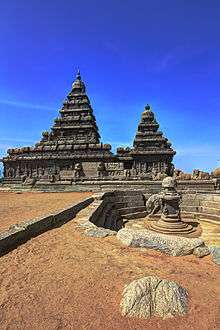
The Gupta period (4th to 6th centuries) saw a flowering of scholarship, the emergence of the classical schools of Hindu philosophy, and of classical Sanskrit literature in general on topics ranging from medicine, veterinary science, mathematics, to astrology and astronomy and astrophysics. The famous Aryabhata and Varahamihira belong to this age. The Gupta established a strong central government which also allowed a degree of local control. Gupta society was ordered in accordance with Hindu beliefs. This included a strict caste system, or class system. The peace and prosperity created under Gupta leadership enabled the pursuit of scientific and artistic endeavors.
The Pallavas (4th to 9th centuries) were, alongside the Guptas of the North, patronisers of Sanskrit in the South of the Indian subcontinent. The Pallava reign saw the first Sanskrit inscriptions in a script called Grantha. Early Pallavas had different connexions to Southeast Asian countries. The Pallavas used Dravidian architecture to build some very important Hindu temples and academies in Mamallapuram, Kanchipuram and other places; their rule saw the rise of great poets, who are as famous as Kalidasa.
The practice of dedicating temples to different deities came into vogue followed by fine artistic temple architecture and sculpture (see Vastu Shastra).
Bhakti
This period saw the emergence of the Bhakti movement. The Bhakti movement was a rapid growth of bhakti beginning in Tamil Nadu in Southern India with the Saiva Nayanars (4th to 10th centuries CE)[157] and the Vaisnava Alvars (3rd to 9th centuries CE) who spread bhakti poetry and devotion throughout India by the 12th to 18th centuries CE.[158][157]
Expansion in South-East Asia
 Expansion of Hinduism in Southeast Asia
Expansion of Hinduism in Southeast Asia Angkor Wat in Cambodia is one of the largest Hindu monuments in the world. It is one of hundreds of ancient Hindu temples in Southeast Asia.
Angkor Wat in Cambodia is one of the largest Hindu monuments in the world. It is one of hundreds of ancient Hindu temples in Southeast Asia.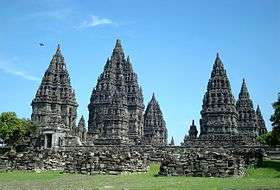 Prambanan in Java is a Hindu temple complex dedicated to Trimurti. It was built during the Sanjaya dynasty of Mataram Kingdom.
Prambanan in Java is a Hindu temple complex dedicated to Trimurti. It was built during the Sanjaya dynasty of Mataram Kingdom.- Hoà Lai Towers in Ninh Thuận, Vietnam, a Hindu temple complex built in the 9th century by the Champa Kingdom of Panduranga.
 Pura Besakih, the holiest temple of Hindu religion in Bali.
Pura Besakih, the holiest temple of Hindu religion in Bali.
Hindu influences reached the Indonesian Archipelago as early as the first century.[159] At this time, India started to strongly influence Southeast Asian countries. Trade routes linked India with southern Burma, central and southern Siam, lower Cambodia and southern Vietnam and numerous urbanised coastal settlements were established there.
For more than a thousand years, Indian Hindu/Buddhist influence was, therefore, the major factor that brought a certain level of cultural unity to the various countries of the region. The Pali and Sanskrit languages and the Indian script, together with Theravada and Mahayana Buddhism, Brahmanism and Hinduism, were transmitted from direct contact as well as through sacred texts and Indian literature, such as the Ramayana and the Mahabharata epics.
From the 5th to the 13th century, South-East Asia had very powerful Indian colonial empires and became extremely active in Hindu and Buddhist architectural and artistic creation. The Sri Vijaya Empire to the south and the Khmer Empire to the north competed for influence.
Langkasuka (-langkha Sanskrit for "resplendent land" -sukkha of "bliss") was an ancient Hindu kingdom located in the Malay Peninsula. The kingdom, along with Old Kedah settlement, are probably the earliest territorial footholds founded on the Malay Peninsula. According to tradition, the founding of the kingdom happened in the 2nd century; Malay legends claim that Langkasuka was founded at Kedah, and later moved to Pattani.
From the 5th to 15th centuries Sri Vijayan empire, a maritime empire centred on the island of Sumatra in Indonesia, had adopted Mahayana and Vajrayana Buddhism under a line of rulers named the Sailendras. The Empire of Sri Vijaya declined due to conflicts with the Chola rulers of India. The Majapahit Empire succeeded the Singhasari empire. It was one of the last and greatest Hindu empires in maritime Southeast Asia.
Funan was a pre-Angkor Cambodian kingdom, located around the Mekong delta, probably established by Mon-Khmer settlers speaking an Austroasiatic language. According to reports by two Chinese envoys, K'ang T'ai and Chu Ying, the state was established by an Indian Brahmin named Kaundinya, who in the 1st century CE was given instruction in a dream to take a magic bow from a temple and defeat a Khmer queen, Soma. Soma, the daughter of the king of the Nagas, married Kaundinya and their lineage became the royal dynasty of Funan. The myth had the advantage of providing the legitimacy of both an Indian Brahmin and the divinity of the cobras, who at that time were held in religious regard by the inhabitants of the region.
The kingdom of Champa (or Lin-yi in Chinese records) controlled what is now south and central Vietnam from approximately 192 through 1697. The dominant religion of the Cham people was Hinduism and the culture was heavily influenced by India.
Later, from the 9th to the 13th century, the Mahayana Buddhist and Hindu Khmer Empire dominated much of the South-East Asian peninsula. Under the Khmer, more than 900 temples were built in Cambodia and in neighboring Thailand. Angkor was at the centre of this development, with a temple complex and urban organisation able to support around one million urban dwellers. The largest temple complex of the world, Angkor Wat, stands here; built by the king Vishnuvardhan.
Late-Classical Hinduism – Puranic Hinduism (c. 650–1200 CE)
.jpg)
After the end of the Gupta Empire and the collapse of the Harsha Empire, power became decentralised in India. Several larger kingdoms emerged, with "countless vasal states".[161][note 35] The kingdoms were ruled via a feudal system. Smaller kingdoms were dependent on the protection of the larger kingdoms. "The great king was remote, was exalted and deified",[161] as reflected in the Tantric Mandala, which could also depict the king as the centre of the mandala.[162]
The disintegration of central power also lead to regionalisation of religiosity, and religious rivalry.[163][note 36] Local cults and languages were enhanced, and the influence of "Brahmanic ritualistic Hinduism"[163] was diminished.[163] Rural and devotional movements arose, along with Shaivism, Vaisnavism, Bhakti and Tantra,[163] though "sectarian groupings were only at the beginning of their development".[163] Religious movements had to compete for recognition by the local lords.[163] Buddhism lost its position after the 8th century, and began to disappear in India.[163] This was reflected in the change of puja-ceremonies at the courts in the 8th century, where Hindu gods replaced the Buddha as the "supreme, imperial deity".[note 37]
Puranic Hinduism
.jpg)
The Brahmanism of the Dharmashastras and the smritis underwent a radical transformation at the hands of the Purana composers, resulting in the rise of Puranic Hinduism,[41] "which like a colossus striding across the religious firmanent soon came to overshadow all existing religions".[166] Puranic Hinduism was a "multiplex belief-system which grew and expanded as it absorbed and synthesised polaristic ideas and cultic traditions".[166] It was distinguished from its Vedic Smarta roots by its popular base, its theological and sectarioan pluralism, its Tantric veneer, and the central place of bhakti.[166][note 9]
The early mediaeval Puranas were composed to disseminate religious mainstream ideology among the pre-literate tribal societies undergoing acculturation.[41] With the breakdown of the Gupta empire, gifts of virgin waste-land were heaped on brahmanas,[46][167] to ensure profitable agrarian exploitation of land owned by the kings,[46] but also to provide status to the new ruling classes.[46] Brahmanas spread further over India, interacting with local clans with different religions and ideologies.[46] The Brahmanas used the Puranas to incorporate those clans into the agrarian society and its accompanying religion and ideology.[46] According to Flood, "[t]he Brahmans who followed the puranic religion became known as smarta, those whose worship was based on the smriti, or pauranika, those based on the Puranas."[168] Local chiefs and peasants were absorbed into the varna, which was used to keep "control over the new kshatriyas and shudras."[169]
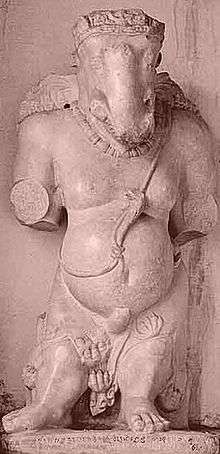
The Brahmanic group was enlarged by incorporating local subgroups, such as local priests.[46] This also lead to stratification within the Brahmins, with some Brahmins having a lower status than other Brahmins.[46] The use of caste worked better with the new Puranic Hinduism than with the Sramanic sects.[169] The Puranic texts provided extensive genealogies which gave status to the new kshatriyas.[169] Buddhist myths pictured government as a contract between an elected ruler and the people.[169] And the Buddhist chakkavatti[note 38] "was a distinct concept from the models of conquest held up to the kshatriyas and the Rajputs".[169]
Many local religions and traditions were assimilated into puranic Hinduism. Vishnu and Shiva emerged as the main deities, together with Sakti/Deva.[170] Vishnu subsumed the cults of Narayana, Jagannaths, Venkateswara "and many others".[170] Nath:
[S]ome incarnations of Vishnu such as Matsya, Kurma, Varaha and perhaps even Nrsimha helped to incorporate certain popular totem symbols and creation myths, especially those related to wild boar, which commonly permeate preliterate mythology, others such as Krsna and Balarama became instrumental in assimilating local cults and myths centering around two popular pastoral and agricultural gods.[171]
The transformation of Brahmanism into Pauranic Hinduism in post-Gupta India was due to a process of acculturation. The Puranas helped establish a religious mainstream among the pre-literate tribal societies undergoing acculturation. The tenets of Brahmanism and of the Dharmashastras underwent a radical transformation at the hands of the Purana composers, resulting in the rise of a mainstream "Hinduism" that overshadowed all earlier traditions.[46]
Bhakti movement
.jpg)
Rama and Krishna became the focus of a strong bhakti tradition, which found expression particularly in the Bhagavata Purana. The Krishna tradition subsumed numerous Naga, yaksa and hill and tree-based cults.[172] Siva absorbed local cults by the suffixing of Isa or Isvara to the name of the local deity, for example, Bhutesvara, Hatakesvara, Chandesvara.[170] In 8th-century royal circles, the Buddha started to be replaced by Hindu gods in pujas.[note 39] This also was the same period of time the Buddha was made into an avatar of Vishnu.[174]
The first documented bhakti movement was founded by Karaikkal-ammaiyar. She wrote poems in Tamil about her love for Shiva and probably lived around the 6th century CE. The twelve Alvars who were Vaishnavite devotees and the sixty-three Nayanars who were Shaivite devotees nurtured the incipient bhakti movement in Tamil Nadu.
During the 12th century CE in Karnataka, the Bhakti movement took the form of the Virashaiva movement. It was inspired by Basavanna, a Hindu reformer who created the sect of Lingayats or Shiva bhaktas. During this time, a unique and native form of Kannada literature-poetry called Vachanas was born.
Advaita Vedanta

Shankara (8th century CE) consolidated the doctrine of Advaita Vedanta.[176][177] Shankara propounded a unified reality, in which the innermost self of a person (atman) and the supernatural power of the entire world (brahman) are one and the same. Perceiving the changing multiplicity of forms and objects as the final reality is regarded as maya, "illusion," obscuring the unchanging ultimate reality of brahman.[178][179][180][181]
Shankara himself, and his grand-teacher Gaudapada, were influenced by Buddhism.[182][183][184][185] Gaudapda took over the Buddhist doctrines that ultimate reality is pure consciousness (vijñapti-mātra)[186] and "that the nature of the world is the four-cornered negation".[186] Gaudapada "wove [both doctrines] into a philosophy of the Mandukya Upanishad, which was further developed by Shankara".[183] Gaudapada also took over the Buddhist concept of "ajāta" from Nagarjuna's Madhyamaka philosophy.[184][185] Shankara succeeded in reading Gaudapada's mayavada[187][note 40] into Badarayana's Brahma Sutras, "and give it a locus classicus",[187] against the realistic strain of the Brahma Sutras.[187]
Shankara is the founder of the Dashanami Sampradaya of Hindu monasticism and Shanmata tradition of worship. Shankara is also regarded as the greatest teacher[188] and reformer of the Smarta tradition.[189][188] According to Hinduism-guide.com:
Not all Brahmins specialized in this Smriti tradition. Some were influenced by Buddhism, Jainism or Charvaka tradition and philosophy. This did not mean that all these people rejected the authority of Vedas, but only that their tradition of worship and philosophy was based not on Smriti texts. In time, Shankaracharya brought all the Vedic communities together. He tried to remove the non-Smriti aspects that had crept into the Hindu communities. He also endeavoured to unite them by arguing that any of the different Hindu gods could be worshipped, according to the prescriptions given in the Smriti texts. He established that worship of various deities are compatible with Vedas and is not contradictory, since all are different manifestations of one nirguna Brahman. Shankaracharya was instrumental in reviving interest in the Smritis.[web 11]
In modern times, due to the influence of western Orientalism and Perennialism on Indian Neo-Vedanta and Hindu nationalism,[129] Advaita Vedanta has acquired a broad acceptance in Indian culture and beyond as the paradigmatic example of Hindu spirituality.[129]
Contact with Persia and Mesopotamia
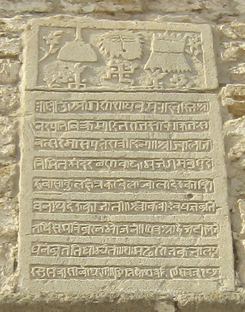
Hindu and also Buddhist religious and secular learning had first reached Persia in an organised manner in the 6th century, when the Sassanid Emperor Khosrau I (531–579) deputed Borzuya the physician as his envoy, to invite Indian and Chinese scholars to the Academy of Gundishapur. Burzoe had translated the Sanskrit Panchatantra. His Pahlavi version was translated into Arabic by Ibn al-Moqaffa under the title of Kalila and Dimna or The Fables of Bidpai.[190]
Under the Abbasid caliphate, Baghdad had replaced Gundishapur as the most important centre of learning in the then vast Islamic Empire, wherein the traditions, as well as scholars of the latter, flourished. Hindu scholars were invited to the conferences on sciences and mathematics held in Baghdad.[191]
Medieval and early modern periods (c. 1200–1850 CE)
Muslim rule
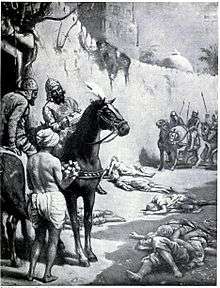 The image, in the chapter on India in Hutchison's Story of the Nations edited by James Meston, depicts the Muslim Turkic general Muhammad Bakhtiyar Khilji's massacre of Buddhist monks in Bihar, India. Khaliji destroyed the Nalanda and Vikramshila universities during his raids across North Indian plains, massacring many Buddhist and Brahmin scholars.[192]
The image, in the chapter on India in Hutchison's Story of the Nations edited by James Meston, depicts the Muslim Turkic general Muhammad Bakhtiyar Khilji's massacre of Buddhist monks in Bihar, India. Khaliji destroyed the Nalanda and Vikramshila universities during his raids across North Indian plains, massacring many Buddhist and Brahmin scholars.[192].jpg) The Kashi Vishwanath Temple was destroyed by the army of Delhi Sultan Qutb-ud-din Aibak.[193]
The Kashi Vishwanath Temple was destroyed by the army of Delhi Sultan Qutb-ud-din Aibak.[193]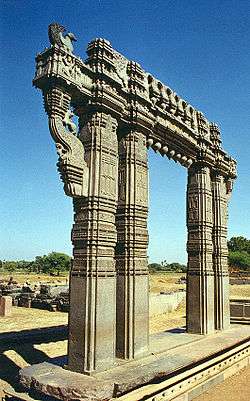 Kakatiya Kala Thoranam (Warangal Gate) built by the Kakatiya dynasty in ruins; one of the many temple complexes destroyed by the Delhi Sultanate.[193]
Kakatiya Kala Thoranam (Warangal Gate) built by the Kakatiya dynasty in ruins; one of the many temple complexes destroyed by the Delhi Sultanate.[193]
Though Islam came to the Indian subcontinent in the early 7th century with the advent of Arab traders, it started impacting Indian religions after the 10th century, and particularly after the 12th century with the establishment and then expansion of Islamic rule.[194][195] Will Durant calls the Muslim conquest of India "probably the bloodiest story in history".[196] During this period, Buddhism declined rapidly while Hinduism faced military-led and Sultanates-sponsored religious violence.[196][197] There was a widespread practice of raids, seizure and enslavement of families of Hindus, who were then sold in Sultanate cities or exported to Central Asia.[198][199] Some texts suggest a number of Hindus were forcibly converted to Islam.[200][201] Starting with the 13th century, for a period of some 500 years, very few texts, from the numerous written by Muslim court historians, mention any "voluntary conversions of Hindus to Islam", suggesting the insignificance and perhaps rarity of such conversions.[201] Typically enslaved Hindus converted to Islam to gain their freedom.[202] There were occasional exceptions to religious violence against Hinduism. Akbar, for example, recognized Hinduism, banned enslavement of the families of Hindu war captives, protected Hindu temples, and abolished discriminatory Jizya (head taxes) against Hindus.[198][203] However, many Muslim rulers of Delhi Sultanate and Mughal Empire, before and after Akbar, from the 12th to 18th centuries, destroyed Hindu temples[web 12][204][web 13][note 41] and persecuted non-Muslims. As noted by Alain Daniélou:
From the time Muslims started arriving, around 632 AD, the history of India becomes a long, monotonous series of murders, massacres, spoliations, and destructions. It is, as usual, in the name of 'a holy war' of their faith, of their sole God, that the barbarians have destroyed civilizations, wiped out entire races.[205]
Unifying Hinduism
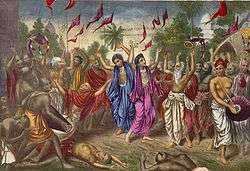 Chaitanya Mahaprabhu, chief proponent of the Achintya Bheda Abheda and Gaudiya Vaishnavism tradition within Hinduism, and Nityananda, is shown performing a 'kirtan' in the streets of Nabadwip, Bengal.[206]
Chaitanya Mahaprabhu, chief proponent of the Achintya Bheda Abheda and Gaudiya Vaishnavism tradition within Hinduism, and Nityananda, is shown performing a 'kirtan' in the streets of Nabadwip, Bengal.[206]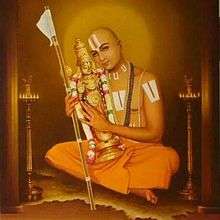 Ramanuja is one of the most important exponents of the Sri Vaishnavism tradition within Hinduism, depicted with Vaishnava Tilaka and Varadraja (Vishnu) statue.[207]
Ramanuja is one of the most important exponents of the Sri Vaishnavism tradition within Hinduism, depicted with Vaishnava Tilaka and Varadraja (Vishnu) statue.[207]
Hinduism underwent profound changes, aided in part by teachers such as Ramanuja, Madhva, and Chaitanya.[194] Followers of the Bhakti movement moved away from the abstract concept of Brahman, which the philosopher Adi Shankara consolidated a few centuries before, with emotional, passionate devotion towards the more accessible Avatars, especially Krishna and Rama.[209] According to Nicholson, already between the 12th and the 16th century, "certain thinkers began to treat as a single whole the diverse philosophical teachings of the Upanishads, epics, Puranas, and the schools known retrospectively as the 'six systems' (saddarsana) of mainstream Hindu philosophy."[210][note 42] Michaels notes that a historicization emerged which preceded later nationalism, articulating ideas which glorified Hinduism and the past.[211]
Eastern Ganga and Surya States
Eastern Ganga and Surya were Hindu polities, which ruled much of present-day Odisha (historically known as Kalinga) from the 11th century till the mid-16th century CE. During the 13th and 14th centuries, when large parts of India were under the rule of Muslim powers, an independent Kalinga became a stronghold of Hindu religion, philosophy, art, and architecture. The Eastern Ganga rulers were great patrons of religion and the arts, and the temples they built are considered among the masterpieces of Hindu architecture.[212][213]
Early Modern period (c. 1500–1850 CE)
The fall of Vijayanagar Empire to Muslim rulers had marked the end of Hindu imperial assertions in the Deccan. But, taking advantage of an over-stretched Mughal Empire (1526–1857), Hinduism once again rose to political prestige, under the Maratha Empire, from 1674 to 1818.
Vijayanagar Empire
The Vijayanagar Empire was established in 1336 by Harihara I and his brother Bukka Raya I of Sangama Dynasty,[214] which originated as a political heir of the Hoysala Empire, Kakatiya Empire,[215] and the Pandyan Empire.[216] The empire rose to prominence as a culmination of attempts by the south Indian powers to ward off Islamic invasions by the end of the 13th century. According to one narrative, the empire's founders Harihara Raya I and Bukka Raya I were two brothers in the service of the Kampili chief. After Kampili fell to the Muslim invasion, they were taken to Delhi and converted to Islam. They were sent back to Kampili as the Delhi Sultan's vassals. After gaining power in the region, they approached Vidyaranya, who converted them back to the Hindu faith.[217]
The Vijayanagara Emperors were tolerant of all religions and sects, as writings by foreign visitors show.[218] The kings used titles such as Gobrahamana Pratipalanacharya (literally, "protector of cows and Brahmins") and Hindurayasuratrana (lit. "upholder of Hindu faith") that testified to their intention of protecting Hinduism and yet were at the same time staunchly Islamicate in their court ceremonials and dress.[219] The empire's founders, Harihara I and Bukka Raya I, were devout Shaivas (worshippers of Shiva), but made grants to the Vaishnava order of Sringeri with Vidyaranya as their patron saint, and designated Varaha (the boar, an avatar of Vishnu) as their emblem.[220] Over one-fourth of the archaeological dig found an "Islamic Quarter" not far from the "Royal Quarter". Nobles from Central Asia's Timurid kingdoms also came to Vijayanagara. The later Saluva and Tuluva kings were Vaishnava by faith, but worshipped at the feet of Lord Virupaksha (Shiva) at Hampi as well as Lord Venkateshwara (Vishnu) at Tirupati. A Sanskrit work, Jambavati Kalyanam by King Krishnadevaraya, called Lord Virupaksha Karnata Rajya Raksha Mani ("protective jewel of Karnata Empire").[221] The kings patronised the saints of the dvaita order (philosophy of dualism) of Madhvacharya at Udupi.[222]
 Market place at Hampi and the sacred tank located near the Krishna temple
Market place at Hampi and the sacred tank located near the Krishna temple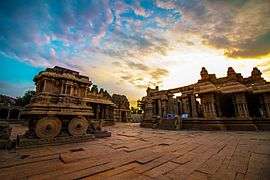 Stone temple car in the Vitthala Temple at Hampi
Stone temple car in the Vitthala Temple at Hampi- Virupaksha Temple is dedicated to Lord Virupaksha, a form of Shiva.
- An open mantapa with yali columns at the Vittala temple in Hampi
The Bhakti (devotional) movement was active during this time, and involved well known Haridasas (devotee saints) of that time. Like the Virashaiva movement of the 12th century, this movement presented another strong current of devotion, pervading the lives of millions. The haridasas represented two groups, the Vyasakuta and Dasakuta, the former being required to be proficient in the Vedas, Upanishads and other Darshanas, while the Dasakuta merely conveyed the message of Madhvacharya through the Kannada language to the people in the form of devotional songs (Devaranamas and Kirthanas). The philosophy of Madhvacharya was spread by eminent disciples such as Naraharitirtha, Jayatirtha, Sripadaraya, Vyasatirtha, Vadirajatirtha and others.[223] Vyasatirtha, the guru (teacher) of Vadirajatirtha, Purandaradasa (Father of Carnatic music[224][225]) and Kanakadasa[226] earned the devotion of King Krishnadevaraya.[227][228][229] The king considered the saint his Kuladevata (family deity) and honoured him in his writings.[230] During this time, another great composer of early carnatic music, Annamacharya composed hundreds of Kirthanas in Telugu at Tirupati in present-day Andhra Pradesh.[231]
The Vijayanagara Empire created an epoch in South Indian history that transcended regionalism by promoting Hinduism as a unifying factor. The empire reached its peak during the rule of Sri Krishnadevaraya when Vijayanagara armies were consistently victorious. The empire annexed areas formerly under the Sultanates in the northern Deccan and the territories in the eastern Deccan, including Kalinga, while simultaneously maintaining control over all its subordinates in the south.[232] Many important monuments were either completed or commissioned during the time of Krishna Deva Raya.
Vijayanagara went into decline after the defeat in the Battle of Talikota (1565). After the death of Aliya Rama Raya in the Battle of Talikota, Tirumala Deva Raya started the Aravidu dynasty, moved and founded a new capital of Penukonda to replace the destroyed Hampi, and attempted to reconstitute the remains of Vijayanagara Empire.[233] Tirumala abdicated in 1572, dividing the remains of his kingdom to his three sons, and pursued a religious life until his death in 1578. The Aravidu dynasty successors ruled the region but the empire collapsed in 1614, and the final remains ended in 1646, from continued wars with the Bijapur Sultanate and others.[234][235][236] During this period, more kingdoms in South India became independent and separate from Vijayanagara. These include the Mysore Kingdom, Keladi Nayaka, Nayaks of Madurai, Nayaks of Tanjore, Nayakas of Chitradurga and Nayak Kingdom of Gingee – all of which declared independence and went on to have a significant impact on the history of South India in the coming centuries.[237]

Mughal period
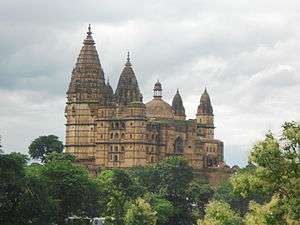
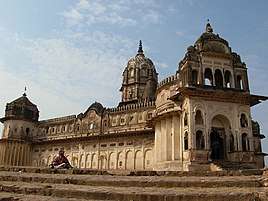
The official state religion of Mughal India was Islam, with the preference to the jurisprudence of the Hanafi Madhhab (Mazhab). Hinduism remained under strain during Babur and Humanyun's reigns. Sher Shah Suri, the Afghan ruler of North India was comparatively non-repressive. Hinduism came to fore during the three-year rule of Hindu ruler Hemu Vikramaditya during 1553–1556 when he had defeated Akbar at Agra and Delhi and had taken up the reign from Delhi as a Hindu 'Vikramaditya' after his 'Rajyabhishake' or coronation at Purana Quila in Delhi. However, during Mughal history, at times, subjects had the freedom to practise any religion of their choice, though non-Muslim able-bodied adult males with income were obliged to pay the jizya, which signified their status as dhimmis.
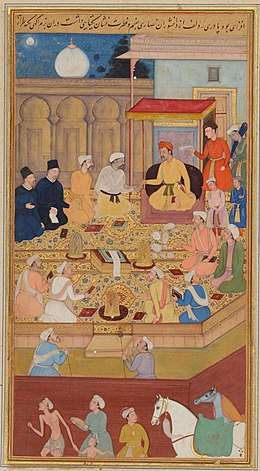
Akbar, the Mughal emperor Humayun's son and heir from his Sindhi queen Hameeda Banu Begum, had a broad vision of Indian and Islamic traditions. One of Emperor Akbar's most unusual ideas regarding religion was Din-i-Ilahi (Faith of God), which was an eclectic mix of Islam, Zoroastrianism, Hinduism, Jainism and Christianity. It was proclaimed the state religion until his death. These actions, however, met with stiff opposition from the Muslim clergy, especially the Sufi Shaykh Alf Sani Ahmad Sirhindi. Akbar's abolition of poll-tax on non-Muslims, acceptance of ideas from other religious philosophies, toleration of public worship by all religions and his interest in other faiths showed an attitude of considerable religious tolerance, which, in the minds of his orthodox Muslim opponents, were tantamount to apostasy. Akbar's imperial expansion acquired many Hindu states, many of whom were Hindu Rajputs, through vassalage. The Rajput vassals maintained semi-autonomy in running religious affairs. Many Hindu Rajput vassals built monumental Hindu temples during the period, such as Chaturbhuj Temple and Lakshmi Temple at Orchha, by the Mughal vassal, the Hindu Rajput Orchha State.[238]
Akbar's son, Jahangir, half Rajput, was also a religious moderate, his mother being Hindu. The influence of his two Hindu queens (the Maharani Maanbai and Maharani Jagat) kept religious moderation as a centre-piece of state policy which was extended under his son, Emperor Shah Jahan, who was by blood 75% Rajput and less than 25% Moghul.
.jpg)
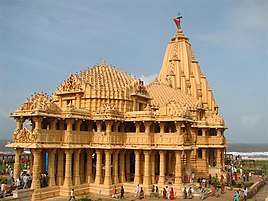
Religious orthodoxy would only play an important role during the reign of Shah Jahan's son and successor, Aurangzeb, a devout Sunni Muslim. Aurangzeb was comparatively less tolerant of other faiths than his predecessors had been; and has been subject to controversy and criticism for his policies that abandoned his predecessors' legacy of pluralism, citing his introduction of the jizya tax, doubling of custom duties on Hindus while abolishing it for Muslims, destruction of Hindu temples, forbidding construction and repairs of some non-Muslim temples, and the executions of Maratha ruler Sambhaji[239][240] and the ninth Sikh guru, Guru Tegh Bahadur,[241] and his reign saw an increase in the number and importance of Islamic institutions and scholars. He led many military campaigns against the remaining non-Muslim powers of the Indian subcontinent – the Sikh states of Punjab, the last independent Hindu Rajputs and the Maratha rebels – as also against the Shia Muslim kingdoms of the Deccan. He also virtually stamped out, from his empire, open proselytisation of Hindus and Muslims by foreign Christian missionaries, who remained successfully active, however, in the adjoining regions: the present day Kerala, Tamil Nadu and Goa.
Maratha Empire
The Hindu Marathas long had lived in the Desh region around Satara, in the western portion of the Deccan plateau, where the plateau meets the eastern slopes of the Western Ghats mountains. They had resisted incursions into the region by the Muslim Mughal rulers of northern India. Under their ambitious leader Shivaji, the Maratha freed themselves from the Muslim sultans of Bijapur to the southeast and, becoming much more aggressive, began to frequently raid Mughal territory, eventually sacking the wealthy Mughal port of Surat in 1664. After substantial territorial gains, Shivaji was proclaimed 'Chhatrapati' (Emperor) in 1674; the Marathas had spread and conquered much of central India by Shivaji's death in 1680. Subsequently, under the able leadership of Brahmin prime ministers (Peshwas), the Maratha Empire reached its zenith; Pune, the seat of Peshwas, flowered as a centre of Hindu learning and traditions. The empire at its peak stretched from Tamil Nadu[242] in the south, to Peshawar (modern-day Khyber Pakhtunkhwa, Pakistan[243] [note 43]) in the north, and Bengal and Andaman Islands in the east.[245] In 1761, the Maratha army lost the Third Battle of Panipat to Ahmad Shah Abdali of the Afghan Durrani Empire which halted their imperial expansion into Afghanistan. Ten years after Panipat, the young Peshwa Madhavrao I's Maratha Resurrection reinstated Maratha authority over North India.
In 1761, the Maratha army lost the Third Battle of Panipat to Ahmad Shah Abdali of the Afghan Durrani Empire which halted their imperial expansion into Afghanistan. Ten years after Panipat, the Peshwa Madhavrao I's Maratha Resurrection reinstated Maratha authority over North India. In a bid to effectively manage the large empire, he gave semi-autonomy to the strongest of the knights, which created a confederacy of Maratha states. They became known as the Gaekwads of Baroda, the Holkars of Indore and Malwa, the Scindias of Gwalior and Ujjain, the Bhonsales of the Nagpur and the Puars of Dhar & Dewas. In 1775, the East India Company intervened in a Peshwa family succession struggle in Pune, which became the First Anglo-Maratha War. The Marathas remained the preeminent power in India until their defeat in the Second Anglo-Maratha War which left the East India Company in control of most of India.
- The last Hindu empire of India, the Maratha Empire, in 1760 CE
 Ahilya Ghat, part of the Ghats in Varanasi, many of which were build by the Marathas[246]
Ahilya Ghat, part of the Ghats in Varanasi, many of which were build by the Marathas[246]
Kingdom of Nepal
King Prithvi Narayan Shah, the last Gorkhali monarch, self-proclaimed the newly unified Kingdom of Nepal as Asal Hindustan ("Real Land of Hindus") due to North India being ruled by the Islamic Mughal rulers. The proclamation was done to enforce Hindu social code Dharmashastra over his reign and refer to his country as being inhabitable for Hindus. He also referred Northern India as Mughlan (Country of Mughals) and called the region infiltrated by Muslim foreigners.[247]
After the Gorkhali conquest of Kathmandu valley, King Prithvi Narayan Shah expelled the Christian Capuchin missionaries from Patan and revisioned Nepal as Asal Hindustan ("real land of Hindus").[248] The Hindu Tagadharis, a Nepalese Hindu socio-religious group, were given the privileged status in the Nepalese capital thereafter.[249][250] Since then Hinduisation became the significant policy of the Kingdom of Nepal.[248] Professor Harka Gurung speculates that the presence of Islamic Mughal rule and Christian British rule in India had compelled the foundation of Brahmin Orthodoxy in Nepal for the purpose building a haven for Hindus in the Kingdom of Nepal.[248]
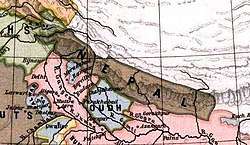 Territory of the Kingdom of Nepal in 1805 CE. The Kingdom of Nepal lasted from 1768 to 2008, and was the last Hindu kingdom in the world.
Territory of the Kingdom of Nepal in 1805 CE. The Kingdom of Nepal lasted from 1768 to 2008, and was the last Hindu kingdom in the world.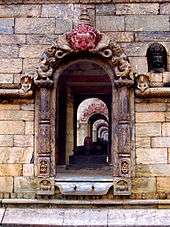 The Shaivaite Pashupatinath temple was built by the Rajput rulers of Nepal.
The Shaivaite Pashupatinath temple was built by the Rajput rulers of Nepal.
Early colonialism
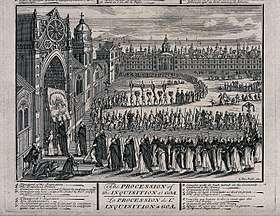
Portuguese missionaries had reached the Malabar Coast in the late 15th century, made contact with the St Thomas Christians in Kerala and sought to introduce the Latin Rite among them. Since the priests for St Thomas Christians were served by the Eastern Christian Churches, they were following Eastern Christian practices at that time. Throughout this period, foreign missionaries also made many new converts to Christianity. This led to the formation of the Latin Catholics in Kerala.
The Goa Inquisition was the office of the Christian Inquisition acting in the Indian city of Goa and the rest of the Portuguese empire in Asia. St. Francis Xavier, in a 1545 letter to John III, requested for an Inquisition to be installed in Goa. It was installed eight years after the death of Francis Xavier in 1552. Established in 1560 and operating until 1774, this highly controversial institution was aimed primarily at Hindus and wayward new converts.
The Battle of Plassey would see the emergence of the British as a political power; their rule later expanded to cover much of India over the next hundred years, conquering all of the Hindu states on the Indian subcontinent,[252] with the exception of the Kingdom of Nepal. While the Maratha Empire remained the preeminent power in India, making it the last remaining Hindu empire,[253] until their defeat in the Second Anglo-Maratha War which left the East India Company in control of most of India; as noted by acting Governor-General Charles Metcalfe, after surveying and analyzing the conditions in India, in 1806 wrote: "India contains no more than two great powers, British and Mahratta."[254][255] During this period, Northeastern India was divided into many kingdoms, most notable being the Kingdom of Manipur, which ruled from their seat of power at Kangla Fort and developed a sophisticated Hindu Gaudiya Vaishnavite culture, later the kingdom became a princely state of the British.[256][257][258] The Kingdom of Mysore was defeated in the Fourth Anglo-Mysore War by the British East India Company, leading to the reinstatement of the Hindu Wadiyar dynasty in Mysore as a princely states.[259] In 1817, the British went to war with the Pindaris, raiders who were based in Maratha territory, which quickly became the Third Anglo-Maratha War, and the British government offered its protection to the mainly Hindu Rajput rulers of Rajputana from the Pindaris and the Marathas.[260] The mainly Hindu Palaiyakkarar states emerged from the fall of the Vijayanagara Empire, and were a bastion of Hindu resistance; and managed to weather invasions and survive till the advent of the British.[261] From 1799 to 1849, the Sikh Empire, ruled by members of the Sikh religion, emerged as the last major indigenous power in the Northwest of the Indian subcontinent under the leadership of Maharaja Ranjit Singh.[262][263] After the death of Ranjit Singh, the empire weakened, alienating Hindu vassals and Wazirs, and leading to the conflict with the British East India Company, marked the downfall of the Sikh Empire, making it among the last areas of the Indian subcontinent to be conquered by the British. The entire subcontinent fell under British rule (partly indirectly, via princely states) following the Indian Rebellion of 1857.
Modern Hinduism (after c. 1850 CE)

With the onset of the British Raj, the colonization of India by the British, there also started a Hindu Renaissance in the 19th century, which profoundly changed the understanding of Hinduism in both India and the west.[266] Indology as an academic discipline of studying Indian culture from a European perspective was established in the 19th century, led by scholars such as Max Müller and John Woodroffe. They brought Vedic, Puranic and Tantric literature and philosophy to Europe and the United States. Western orientalist searched for the "essence" of the Indian religions, discerning this in the Vedas,[267] and meanwhile creating the notion of "Hinduism" as a unified body of religious praxis[129] and the popular picture of 'mystical India'.[129][266] This idea of a Vedic essence was taken over by Hindu reform movements as the Brahmo Samaj, which was supported for a while by the Unitarian Church,[268] together with the ideas of Universalism and Perennialism, the idea that all religions share a common mystic ground.[269] This "Hindu modernism", with proponents like Vivekananda, Aurobindo and Radhakrishnan, became central in the popular understanding of Hinduism.[270][271][272][273][129]
Hindu revivalism

During the 19th century, Hinduism developed a large number of new religious movements, partly inspired by the European Romanticism, nationalism, scientific racism and esotericism (Theosophy) popular at the time (while conversely and contemporaneously, India had a similar effect on European culture with Orientalism, "Hindoo style" architecture, reception of Buddhism in the West and similar). According to Paul Hacker, "the ethcial values of Neo-Hinduism stem from Western philosophy and Christianity, although they are expressed in Hindu terms."[274]
These reform movements are summarised under Hindu revivalism and continue into the present.
- Sahajanand Swami establishes the Swaminarayan Sampraday sect around 1800.[275]
- Brahmo Samaj is a social and religious movement founded in Kolkata in 1828 by Raja Ram Mohan Roy. He was one of the first Indians to visit Europe and was influenced by western thought. He died in Bristol, England. The Brahmo Samaj movement thereafter resulted in the Brahmo religion in 1850 founded by Debendranath Tagore — better known as the father of Rabindranath Tagore.[276]
- Sri Ramakrishna and his pupil Swami Vivekananda led reform in Hinduism in the late 19th century. Their ideals and sayings have inspired numerous Indians as well as non-Indians, Hindus as well as non-Hindus.[277]
- Arya Samaj ("Society of Nobles") is a Hindu reform movement in India that was founded by Swami Dayananda in 1875. He was a sannyasin (renouncer) who believed in the infallible authority of the Vedas. Dayananda advocated the doctrine of karma and reincarnation, and emphasised the ideals of brahmacharya (chastity) and sanyasa (renunciation). Dayananda claimed to be rejecting all non-Vedic beliefs altogether. Hence the Arya Samaj unequivocally condemned idolatry, animal sacrifices, ancestor worship, pilgrimages, priestcraft, offerings made in temples, the caste system, untouchability and child marriages, on the grounds that all these lacked Vedic sanction. It aimed to be a universal church based on the authority of the Vedas. Dayananda stated that he wanted 'to make the whole world Aryan', i.e. he wanted to develop missionary Hinduism based on the universality of the Vedas. To this end, the Arya Samaj started Shuddhi movement in the early 20th century to bring back to Hinduism people converted to Islam and Christianity, set up schools and missionary organisations, and extended its activities outside India.[278][279][280]
Reception in the West
An important development during the British colonial period was the influence Hindu traditions began to form on Western thought and new religious movements. An early champion of Indian-inspired thought in the West was Arthur Schopenhauer who in the 1850s advocated ethics based on an "Aryan-Vedic theme of spiritual self-conquest", as opposed to the ignorant drive toward earthly utopianism of the superficially this-worldly "Jewish" spirit.[281] Helena Blavatsky moved to India in 1879, and her Theosophical Society, founded in New York in 1875, evolved into a peculiar mixture of Western occultism and Hindu mysticism over the last years of her life.
The sojourn of Vivekananda to the World Parliament of Religions in Chicago in 1893 had a lasting effect. Vivekananda founded the Ramakrishna Mission, a Hindu missionary organisation still active today.
In the early 20th century, Western occultists influenced by Hinduism include Maximiani Portaz – an advocate of "Aryan Paganism" – who styled herself Savitri Devi and Jakob Wilhelm Hauer, founder of the German Faith Movement. It was in this period, and until the 1920s, that the swastika became a ubiquitous symbol of good luck in the West before its association with the Nazi Party became dominant in the 1930s.
Hinduism-inspired elements in Theosophy were also inherited by the spin-off movements of Ariosophy and Anthroposophy and ultimately contributed to the renewed New Age boom of the 1960s to 1980s, the term New Age itself deriving from Blavatsky's 1888 The Secret Doctrine.
Influential 20th-century Hindus were Ramana Maharshi, B.K.S. Iyengar, Paramahansa Yogananda, Prabhupada (founder of ISKCON), Sri Chinmoy, Swami Rama and others who translated, reformulated and presented Hinduism's foundational texts for contemporary audiences in new iterations, raising the profiles of Yoga and Vedanta in the West and attracting followers and attention in India and abroad.
Contemporary Hinduism
Hinduism is followed by around 1.1 billion people in India.[web 14] Other significant populations are found in Nepal (23 million), Bangladesh (15 million) and the Indonesian island of Bali (3.9 million).[282] The majority of the Vietnamese Cham people also follow Hinduism, with the largest proportion in Ninh Thuận Province.[283]
Neo-Hindu movements in the West
In modern times Smarta-views have been highly influential in both the Indian[web 15] and western[web 16] understanding of Hinduism via Neo-Vedanta. Vivekananda was an advocate of Smarta-views,[web 16] and Radhakrishnan was himself a Smarta-Brahman.[284][285] According to iskcon.org,
Many Hindus may not strictly identify themselves as Smartas but, by adhering to Advaita Vedanta as a foundation for non-sectarianism, are indirect followers.[web 15]
Influential in spreading Hinduism to a western audience were Swami Vivekananda, Paramahansa Yogananda, A.C. Bhaktivedanta Swami Prabhupada (Hare Krishna movement), Sri Aurobindo, Meher Baba, Maharishi Mahesh Yogi (Transcendental Meditation), Jiddu Krishnamurti, Sathya Sai Baba, Mother Meera, among others.
Hindutva
In the 20th century, Hinduism also gained prominence as a political force and a source for national identity in India. With origins traced back to the establishment of the Hindu Mahasabha in the 1910s, the movement grew with the formulation and development of the Hindutva ideology in the following decades; the establishment of Rashtriya Swayamsevak Sangh (RSS) in 1925; and the entry, and later success, of RSS offshoots Jana Sangha and Bharatiya Janata Party (BJP) in electoral politics in post-independence India.[286] Hindu religiosity plays an important role in the nationalist movement.[287][note 44][note 45]
 Map of Akhanda Bhārata proper, consisting of South Asia and Myanmar
Map of Akhanda Bhārata proper, consisting of South Asia and Myanmar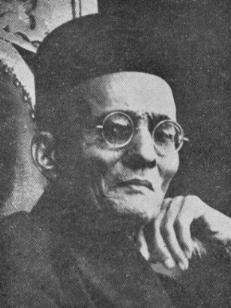
See also
- Indianisation
- Greater India
- Indomania
- Indosphere
- Sanskritization
- List of Hindu Empires and Dynasties
- India as major ancient great power
- Hinduism by country
- Indianization of Southeast Asia
- History of India
- Indian religions
- Religion in India
- History of Yoga
- History of Shaivism
- History of Buddhism
Notes
- See:
- "Oldest religion":
- The "oldest living religion"[5]
- The "oldest living major religion" in the world.[6][7]
- Urreligion, Shamanism, Animism, Ancestor worship for some of the oldest forms of religion
- Sarnaism and Sanamahism, Indian Tribal religions connected to the earliest migrations into India
- Australian Aboriginal mythology, one of the oldest surviving religions in the world.
- Among its roots are the Vedic religion[14] of the late Vedic period and its emphasis on the status of Brahmans,[17] but also the religions of the Indus Valley Civilisation,[15][18][19][20] the Sramana[21] or renouncer traditions[14] of east India,[21] and "popular or local traditions".[14]
- There is no exact dating possible for the beginning of the Vedic period. Witzel mentions a range between 1900 and 1400 BCE.[23] Flood mentions 1500 BCE.[24]
- Lockard (2007, p. 50): "The encounters that resulted from Aryan migration brought together several very different peoples and cultures, reconfiguring Indian society. Over many centuries a fusion of Aryan and Dravidian occurred, a complex process that historians have labeled the Indo-Aryan synthesis." Lockard: "Hinduism can be seen historically as a synthesis of Aryan beliefs with Harappan and other Dravidian traditions that developed over many centuries."
- Hiltebeitel (2007, p. 12): "A period of consolidation, sometimes identified as one of "Hindu synthesis," Brahmanic synthesis," or "orthodox synthesis," takes place between the time of the late Vedic Upanishads (c. 500 BCE) and the period of Gupta imperial ascendency" (c. 320-467 CE)."
- See also:
- J.H. Hutton (1931), in Ghurye, Govind Sadashiv (1980), The Scheduled Tribes of India, Transaction Publishers, pp. 3–4[subnote 1]
- Zimmer, Heinrich (1951), Philosophies of India, Princeton University Press, pp. 218–219
- Tyler (1973), India: An Anthropological Perspective, Goodyear Publishing Company. In: Sjoberg 1990, p. 43[subnote 2]
- Sjoberg, Andree F. (1990), "The Dravidian Contribution To The Development Of Indian Civilization: A Call For A Reassesment", Comparative Civilizations Review, 23: 40–74
- Flood, Gavin D. (1996), An Introduction to Hinduism, Cambridge University Press, p. 16
- Nath, Vijay (2001), "From 'Brahmanism' to 'Hinduism': Negotiating the Myth of the Great Tradition", Social Scientist: 19–50
- Werner, karel (2005), A Popular Dictionary of Hinduism, Routledge, pp. 8–9
- Lockard, Craig A. (2007), Societies, Networks, and Transitions. Volume I: to 1500, Cengage Learning, p. 50
- Hiltebeitel, Alf (2007), Hinduism. In: Joseph Kitagawa, "The Religious Traditions of Asia: Religion, History, and Culture", Routledge
- Hopfe, Lewis M.; Woodward, Mark R. (2008), Religions of the World, Pearson Education, p. 79[subnote 3]
- Samuel, Geoffrey (2010), The Origins of Yoga and Tantra. Indic Religions to the Thirteenth Century, Cambridge University Press
- See:
- White (2006, p. 28): "[T]he religion of the Vedas was already a composite of the indo-Aryan and Harappan cultures and civilizations."
- Gombrich (1996, pp. 35–36): "It is important to bear in mind that the Indo-Aryans did not enter an unhabitated land. For nearly two millennia they and their culture gradually penetrated India, moving east and south from their original seat in the Punjab. They mixed with people who spoke Munda or Dravidian languages, who have left no traces of their culture beyond some archaeological remains; we know as little about them as we would about the Indo-Aryans if they had left no texts. In fact we cannot even be sure whether some of the archaeological finds belong to Indo-Aryans, autochthonous populations, or a mixture. It is to be assumed - though this is not fashionable in Indian historiography - that the clash of cultures between Indo-Aryans and autochtones was responsible for many of the changes in Indo-Aryan society. We can also assume that many - perhaps most - of the indigenous population came to be assimilated into Indo-Aryan culture.
- The date of the production of the written texts does not define the date of origin of the Puranas (Johnson 2009, p. 247). They may have existed in some oral form before being written down (Johnson 2009, p. 247).
- Michaels (2004, p. 38): "The legacy of the Vedic religion in Hinduism is generally overestimated. The influence of the mythology is indeed great, but the religious terminology changed considerably: all the key terms of Hinduism either do not exist in Vedic or have a completely different meaning. The religion of the Veda does not know the ethicised migration of the soul with retribution for acts (karma), the cyclical destruction of the world, or the idea of salvation during one's lifetime (jivanmukti; moksa; nirvana); the idea of the world as illusion (maya) must have gone against the grain of ancient India, and an omnipotent creator god emerges only in the late hymns of the rgveda. Nor did the Vedic religion know a caste system, the burning of widows, the ban on remarriage, images of gods and temples, Puja worship, Yoga, pilgrimages, vegetarianism, the holiness of cows, the doctrine of stages of life (asrama), or knew them only at their inception. Thus, it is justified to see a turning point between the Vedic religion and Hindu religions." See also Halbfass 1991, pp. 1–2
- University of Oslo: "During the period following Ashoka, until the end of the 7th century AD, the great gift ceremonies honoring the Buddha remained the central cult of Indian imperial kingdoms".[web 1]
- Samuel (2010, p. 76): "Certainly, there is substantial textual evidence for the outward expansion of Vedic-Brahmanical culture." Samuel (2010, p. 77): "[T]he Buddhist sutras describe what was in later periods a standard mechanism for the expansion of Vedic-Brahmanical culture: the settlement of Brahmins on land granted by local rulers." See also Vijay Nath (2001). Samuel (2010, p. 199): "By the first and second centuries CE, the Dravidian-speaking regions of the south were also increasingly being incorporated into the general North and Central Indian cultural pattern, as were parts at least of Southeast Asia. The Pallava kingdom in South India was largely Brahmanical in orientation although it included a substantial Jain and Buddhist population, while Indic states were also beginning to develop in Southeast Asia."
- Larson (1995, p. 81): "Also, the spread of the culture of North India to the South was accomplished in many instances by the spread of Buddhist and Jain institutions (monasteries, lay communities, and so forth). The Pallavas of Kanci appear to have been one of the main vehicles for the spread of specifically Indo-Brahmanical or Hindu institutions in the South, a process that was largely completed after the Gupta Age. As Basham has noted, "the contact of Aryan and Dravidian produced a vigorous cultural synthesis, which in turn had an immense influence on Indian civilization as a whole."
- Flood (1996, p. 129): "The process of Sanskritization only began to significantly influence the south after the first two centuries CE and Tamil deities and forms of worship became adapted to northern Sanskrit forms."
- Wendy Doniger: "If Sanskritization has been the main means of connecting the various local traditions throughout the subcontinent, the converse process, which has no convenient label, has been one of the means whereby Hinduism has changed and developed over the centuries. Many features of Hindu mythology and several popular gods—such as Ganesha, an elephant-headed god, and Hanuman, the monkey god—were incorporated into Hinduism and assimilated into the appropriate Vedic gods by this means. Similarly, the worship of many goddesses who are now regarded as the consorts of the great male Hindu gods, as well as the worship of individual unmarried goddesses, may have arisen from the worship of non-Vedic local goddesses. Thus, the history of Hinduism can be interpreted as the interplay between orthoprax custom and the practices of wider ranges of people and, complementarily, as the survival of features of local traditions that gained strength steadily until they were adapted by the Brahmans."[web 2] Vijay Nath (2001, p. 31): "Visnu and Siva, on the other hand, as integral components of the Triad while continuing to be a subject of theological speculation, however, in their subsequent "avataras" began to absorb countless local cults and deities within their folds. The latter were either taken to represent the multiple facets of the same god or else were supposed to denote different forms and appellations by which the god came to be known and worshipped. Thus whereas Visnu came to subsume the cults of Narayana, Jagannatha, Venkateswara and many others, Siva became identified with countless local cults by the sheer suffixing of Isa or Isvarato the name of the local deity, e.g., Bhutesvara, Hatakesvara, Chandesvara."
- Wendy Doniger: "The process, sometimes called "Sanskritization," began in Vedic times and was probably the principal method by which the Hinduism of the Sanskrit texts spread through the subcontinent and into Southeast Asia. Sanskritization still continues in the form of the conversion of tribal groups, and it is reflected in the persistence of the tendency among some Hindus to identify rural and local deities with the gods of the Sanskrit texts."[web 2]
- See also Tanvir Anjum, Temporal Divides: A Critical Review of the Major Schemes of Periodization in Indian History.
- Different periods are designated as "classical Hinduism":
- Smart (2003, p. 52) calls the period between 1000 BCE and 100 CE "pre-classical". It is the formative period for the Upanishads and Brahmanism[subnote 4] Jainism and Buddhism. For Smart, the "classical period" lasts from 100 to 1000 CE, and coincides with the flowering of "classical Hinduism" and the flowering and deterioration of Mahayana-buddhism in India.
- For Michaels (2004, pp. 36, 38), the period between 500 BCE and 200 BCE is a time of "Ascetic reformism", whereas the period between 200 BCE and 1100 CE is the time of "classical Hinduism", since there is "a turning point between the Vedic religion and Hindu religions".
- Muesse (2003, p. 14) discerns a longer period of change, namely between 800 BCE and 200 BCE, which he calls the "Classical Period". According to Muesse, some of the fundamental concepts of Hinduism, namely karma, reincarnation and "personal enlightenment and transformation", which did not exist in the Vedic religion, developed in this time.
- Stein (2010, p. 107) The Indian History Congress, formally adopted 1206 CE as the date medieval India began.
- Doniger (2010, p. 66): "Much of what we now call Hinduism may have had roots in cultures that thrived in South Asia long before the creation of textual evidence that we can decipher with any confidence. Remarkable cave paintings have been preserved from Mesolithic sites dating from c. 30,000 BCE in Bhimbetka, near present-day Bhopal, in the Vindhya Mountains in the province of Madhya Pradesh."
- Jones & Ryan (2006, p. xvii): "Some practices of Hinduism must have originated in Neolithic times (c. 4,000 BCE). The worship of certain plants and animals as sacred, for instance, could very likely have very great antiquity. The worship of goddesses, too, a part of Hinduism today, maybe a feature that originated in the Neolithic."
- Mallory 1989, p. 38f. The separation of the early Indo-Aryans from the Proto-Indo-Iranian stage is dated to roughly 1800 BCE in scholarship.
- Michaels (2004, p. 33): "They called themselves arya ("Aryans," literally "the hospitable," from the Vedic arya, "homey, the hospitable") but even in the Rgveda, arya denotes a cultural and linguistic boundary and not only a racial one."
- There is no exact dating possible for the beginning of the Vedic period. Witzel (1995, pp. 3–4) mentions a range between 1900 and 1400 BCE. Flood (1996, p. 21) mentions 1500 BCE.
- Allchin & Erdosy (1995): "There has also been a fairly general agreement that the Proto-Indoaryan speakers at one time lived on the steppes of Central Asia and that at a certain time they moved southwards through Bactria and Afghanistan, and perhaps the Caucasus, into Iran and India-Pakistan (Burrow 1973; Harmatta 1992)."
- Kulke & Rothermund (1998): "During the last decades intensive archaeological research in Russia and the Central Asian Republics of the former Soviet Union as well as in Pakistan and northern India has considerably enlarged our knowledge about the potential ancestors of the Indo-Aryans and their relationship with cultures in west, central and south Asia. Previous excavations in southern Russia and Central Asia could not confirm that the Eurasian steppes had once been the original home of the speakers of Indo-European language."
- The Aryan migration theory has been challenged by some researchers (Michaels 2004, p. 33, Singh 2008, p. 186), due to a lack of archaeological evidence and signs of cultural continuity (Michaels 2004, p. 33), hypothesizing instead a slow process of acculturation or transformation (Michaels 2004, p. 33, Flood 1996, pp. 30–35). Nevertheless, linguistic and archaeological data clearly show a cultural change after 1750 BCE (Michaels 2004, p. 33), with the linguistic and religious data clearly showing links with Indo-European languages and religion (Flood 1996, p. 33). According to Singh 2008, p. 186, "The dominant view is that the Indo-Aryans came to the subcontinent as immigrants."
- Zimmer's point of view is supported by other scholars, such as Niniam Smart, in Doctrine and argument in Indian Philosophy, 1964, p.27-32 & p.76, (Crangle 1994, p. 7) and S.K. Belvakar & R.D. Ranade in History of Indian philosophy, 1974 (1927), p.81 & p.303-409 (Crangle 1994, p. 7).
- Flood (2008, pp. 273–274): "The second half of the first millennium BCE was the period that created many of the ideological and institutional elements that characterise later Indian religions. The renouncer tradition played a central role during this formative period of Indian religious history [...] Some of the fundamental values and beliefs that we generally associate with Indian religions in general and Hinduism, in particular, were in part the creation of the renouncer tradition. These include the two pillars of Indian theologies: samsara - the belief that life in this world is one of suffering and subject to repeated deaths and births (rebirth); moksa/nirvana - the goal of human existence."
- King (1999) notes that Radhakrishnan was a representative of Neo-Vedanta,[129] which had a specific understanding of Indian religions: "The inclusivist appropriation of other traditions, so characteristic of neo-Vedanta ideology, appears on three basic levels. First, it is apparent in the suggestion that the (Advaita) Vedanta philosophy of Sankara (c. eighth century CE) constitutes the central philosophy of Hinduism. Second, in an Indian context, neo-Vedanta philosophy subsumes Buddhist philosophies in terms of its own Vedantic ideology. The Buddha becomes a member of the Vedanta tradition, merely attempting to reform it from within. Finally, at a global level, neo-Vedanta colonises the religious traditions of the world by arguing for the centrality of a non-dualistic position as the philosophia perennis underlying all cultural differences."
- Michaels (2004, p. 38): "At the time of upheaval [500–200 BCE], many elements of the Vedic religion were lost".
- Klostermaier 2007, p. 55: "Kautas, a teacher mentioned in the Nirukta by Yāska (ca. 500 BCE), a work devoted to an etymology of Vedic words that were no longer understood by ordinary people, held that the word of the Veda was no longer perceived as meaningful "normal" speech but as a fixed sequence of sounds, whose meaning was obscure beyond recovery."
- Klostermaier: "Brahman, derived from the root bŗh = to grow, to become great, was originally identical with the Vedic word, that makes people prosper: words were the pricipan means to approach the gods who dwelled in a different sphere. It was not a big step from this notion of "reified speech-act" to that "of the speech-act being looked at implicitly and explicitly as a means to an end." Klostermaier 2007, p. 55 quotes Madhav M. Deshpande (1990), Changing Conceptions of the Veda: From Speech-Acts to Magical Sounds, p.4.
- Hiltebeitel (2007, p. 13): "The emerging self-definitions of Hinduism were forged in the context of continuous interaction with heterodox religions (Buddhists, Jains, Ajivikas) throughout this whole period, and with foreign people (Yavanas, or Greeks; Sakas, or Scythians; Pahlavas, or Parthians; and Kusanas, or Kushans) from the third phase on [between the Mauryan empire and the rise of the Guptas].
- Larson (2009, p. 185): "[I]n contrast to the sruti, which Hindus, for the most part, pay little more than lip service to."
- Michaels (2004, p. 40) mentions the Durga temple in Aihole and the Visnu Temple in Deogarh. Michell (1977, p. 18) notes that earlier temples were built of timber, brick and plaster, while the first stone temples appeared during the period of Gupta rule.
- Michaels (2004, p. 41):
- In the east the Pala Empire (770–1125 CE),
- in the west and north the Gurjara-Pratihara (7th–10th century),
- in the southwest the Rashtrakuta Dynasty (752–973),
- in the Dekkhan the Chalukya dynasty (7th–8th century),
- and in the south the Pallava dynasty (7th–9th century) and the Chola dynasty (9th century).
- McRae (2003): This resembles the development of Chinese Chán during the An Lu-shan rebellion and the Five Dynasties and Ten Kingdoms Period (907–960/979), during which power became decentralised end new Chán-schools emerged.
- Inden (1998, p. 67): "Before the eighth century, the Buddha was accorded the position of universal deity and ceremonies by which a king attained to imperial status were elaborate donative ceremonies entailing gifts to Buddhist monks and the installation of a symbolic Buddha in a stupa ... This pattern changed in the eighth century. The Buddha was replaced as the supreme, imperial deity by one of the Hindu gods (except under the Palas of eastern India, the Buddha's homeland) ... Previously the Buddha had been accorded imperial-style worship (puja). Now as one of the Hindu gods replaced the Buddha at the imperial centre and pinnacle of the cosmo-political system, the image or symbol of the Hindu god comes to be housed in a monumental temple and given increasingly elaborate imperial-style puja worship."
- Thapar (2003, p. 325): The king who ruled not by conquest but by setting in motion the wheel of law.
- Inden: "before the eighth century, the Buddha was accorded the position of universal deity and ceremonies by which a king attained to imperial status were elaborate donative ceremonies entailing gifts to Buddhist monks and the installation of a symbolic Buddha in a stupa ... This pattern changed in the eighth century. The Buddha was replaced as the supreme, imperial deity by one of the Hindu gods (except under the Palas of eastern India, the Buddha's homeland) ... Previously the Buddha had been accorded imperial-style worship (puja). Now as one of the Hindu gods replaced the Buddha at the imperial centre and pinnacle of the cosmo-political system, the image or symbol of the Hindu god comes to be housed in a monumental temple and given increasingly elaborate imperial-style puja worship."[173]
- The term "mayavada" is still being used, in a critical way, by the Hare Krshnas. See [web 7][web 8][web 9][web 10]
- See also "Aurangzeb, as he was according to Mughal Records"; more links at the bottom of that page; for Muslim historian's record on major Hindu temple destruction campaigns, from 1193 to 1729 AD, see Richard Eaton (2000), Temple Desecration and Indo-Muslim States, Journal of Islamic Studies, Vol. 11, Issue 3, pages 283-319
- The tendency of "a blurring of philosophical distinctions" has also been noted by Burley (2007, p. 34). Lorenzen locates the origins of a distinct Hindu identity in the interaction between Muslims and Hindus (Lorenzen 2006, pp. 24–33), and a process of "mutual self-definition with a contrasting Muslim other" which started well before 1800 (Lorenzen 2006, pp. 26–27). Both the Indian and the European thinkers who developed the term "Hinduism" in the 19th century were influenced by these philosophers (Nicholson 2010, p. 2)
- Many historians consider Attock to be the final frontier of the Maratha Empire.[244]
- This conjunction of nationalism and religion is not unique to India. The complexities of Asian nationalism are to be seen and understood in the context of colonialism, modernization and nation-building. See, for example, Anagarika Dharmapala, for the role of Theravada Buddhism in Sri Lankese struggle for independence (McMahan 2008), and D.T. Suzuki, who conjuncted Zen to Japanese nationalism and militarism, in defense against both western hegemony and the pressure on Japanese Zen during the Meiji Restoration to conform to Shinbutsu Bunri (Sharf 1993, Sharf 1995).
- Rinehart (2004, p. 198): Neo-Vedanta also contributed to Hindutva ideology, Hindu politics and communalism. Yet, Rinehart emphasises that it is "clear that there isn't a neat line of causation that leads from the philosophies of Rammohan Roy, Vivekananda and Radhakrishnan to the agenda of [...] militant Hindus."
Subnotes
- Ghurye: He [Hutton] considers modern Hinduism to be the result of an amalgam between pre-Aryan Indian beliefs of Mediterranean inspiration and the religion of the Rigveda. "The Tribal religions present, as it were, surplus material not yet built into the temple of Hinduism".(Ghurye 1980, p. 4)
- Tyler, in India: An Anthropological Perspective(1973), page 68, as quoted by Sjoberg, calls Hinduism a "synthesis" in which the Dravidian elements prevail: "The Hindu synthesis was less the dialectical reduction of orthodoxy and heterodoxy than the resurgence of the ancient, aboriginal Indus civilization. In this process the rude, barbaric Aryan tribes were gradually civilised and eventually merged with the autochthonous Dravidians. Although elements of their domestic cult and ritualism were jealously preserved by Brahman priests, the body of their culture survived only in fragmentary tales and allegories embedded in vast, syncretistic compendia. On the whole, the Aryan contribution to Indian culture is insignificant. The essential pattern of Indian culture was already established in the third millennium B.C., and ... the form of Indian civilization perdured and eventually reasserted itself (Sjoberg 1990, p. 43).
- Hopfe & Woodward (2008, p. 79): "The religion that the Aryans brought with them mingled with the religion of the native people, and the culture that developed between them became classical Hinduism."
- Smart (2003, pp. 52, 83–86) distinguishes "Brahmanism" from the Vedic religion, connecting "Brahmanism" with the Upanishads.
References
- Brodd 2003.
- Fowler 1997, p. 1.
- Gellman 2011.
- Stevens 2001, p. 191.
- Sarma 1953.
- Merriam-Webster 2000, p. 751.
- Klostermaier 2007, p. 1.
- Laderman 2003, p. 119.
- Turner & 1996-B, p. 359.
- Smart 1993, p. 1.
- Lockard 2007, p. 50.
- Hiltebeitel 2007, p. 12.
- Samuel 2010, p. 193.
- Flood 1996, p. 16.
- Narayanan 2009, p. 11.
- Osborne 2005, p. 9.
- Samuel 2010, p. 48-53.
- Lockard 2007, p. 52.
- Hiltebeitel 2007, p. 3.
- Jones 2006, p. xviii.
- Gomez 2013, p. 42.
- Michaels 2004, p. 32-36.
- Witzel 1995, p. 3-4.
- Flood 1996, p. 21.
- Michaels 2004, p. 38.
- Michaels 2004.
- Blackwell's History of India; Stein 2010, page 107
- Some Aspects of Muslim Administration, Dr. R.P.Tripathi, 1956, p.24
- Samuel 2010, p. 41-42.
- White 2006, p. 28.
- Doniger 2010, p. 66.
- Jones & Ryan 2006, p. xvii.
- Narayanan 2009, p. 11; Lockard 2007, p. 52; Hiltebeitel 2007, p. 3; Jones & Ryan 2006, p. xviii
- Tiwari 2002, p. v; Lockard 2007, p. 52; Zimmer 1951, pp. 218–219; Larson 1995, p. 81
- Tiwari 2002, p. v.
- Larson 2009.
- Fuller 2004, p. 88.
- Cousins 2010.
- Hiltebeitel 2007, p. 13.
- Vijay Nath 2001, p. 21.
- Vijay Nath 2001, p. 19.
- Samuel 2010, p. 193-228.
- Raju 1992, p. 31.
- Samuel 2010, p. 193-228, 339-353, specifically p.76-79 and p.199.
- Samuel 2010, p. 77.
- Vijay Nath 2001.
- Vijay Nath 2001, p. 31-34.
- Flood 1996, p. 128, 129, 148.
- Gombrich 2006, p. 36.
- Deutsch & Dalvi 2004, p. 99-100.
- Thapar 1978, p. 19-20.
- Thapar 1978, p. 19.
- Thapar 1978, p. 20.
- Basham 1967
- Frederick J. Simoons (1998). Plants of life, plants of death. p. 363.
- Ranbir Vohra (2000). The Making of India: A Historical Survey. M.E. Sharpe. p. 15.
- Grigoriĭ Maksimovich Bongard-Levin (1985). Ancient Indian Civilization. Arnold-Heinemann. p. 45.
- Steven Rosen, Graham M. Schweig (2006). Essential Hinduism. Greenwood Publishing Group. p. 45.
- Srinivasan, Doris Meth (1997). Many Heads, Arms and Eyes: Origin, Meaning and Form in Multiplicity in Indian Art. Brill. ISBN 978-9004107588.
- Mahadevan, Iravatham (2006). A Note on the Muruku Sign of the Indus Script in light of the Mayiladuthurai Stone Axe Discovery. harappa.com. Archived from the original on 4 September 2006.
- Feuerstein, Georg; Kak, Subhash; Frawley, David (2001). In Search of the Cradle of Civilization:New Light on Ancient India. Quest Books. p. 121. ISBN 0-8356-0741-0.
- Clark, Sharri R. (2007). "The social lives of figurines: recontextualizing the third millennium BC terracotta figurines from Harappa, Pakistan". Harvard PhD. Cite journal requires
|journal=(help) - Thapar, Romila, Early India: From the Origins to 1300, London, Penguin Books, 2002
- McIntosh, Jane. (2008) The Ancient Indus Valley : New Perspectives. ABC-CLIO. Page 84,276
- Sjoberg 1990.
- Mudumby Narasimhachary (Ed) (1976). Āgamaprāmāṇya of Yāmunācārya, Issue 160 of Gaekwad's Oriental Series. Oriental Institute, Maharaja Sayajirao University of Baroda.
- Tripath, S.M. (2001). Psycho-Religious Studies Of Man, Mind And Nature. Global Vision Publishing House. ISBN 9788187746041.
- Nagalingam, Pathmarajah (2009). The Religion of the Agamas. Siddhanta Publications.
- PT Raju (2009), The Philosophical Traditions of India, Routledge, ISBN 978-81-208-0983-3, page 45; Quote: The word Agama means 'coming down', and the literature is that of traditions, which are mixtures of the Vedic with some non-Vedic ones, which were later assimilated to the Vedic.
- Guy Beck (1993), Sonic Theology: Hinduism and Sacred Sound, University of South Carolina Press, ISBN 978-0-87249-855-6, pages 151–152
- Drabu, V. N. (1990). Śaivāgamas: A Study in the Socio-economic Ideas and Institutions of Kashmir (200 B.C. to A.D. 700), Indus Publishing Company. ISBN 978-81-85182-38-4. LCCN lc90905805
- Pletcher, Kenneth (2010). The History of India. Britannica Educational Publishing. p. 60.
- Singh 2008, p. 185.
- Michaels 2004, p. 32.
- Anthony 2007.
- Mukherjee et al. 2011.
- Anthony 2007, p. 408.
- Witzel 1995.
- Michaels 2004, p. 33.
- Flood 1996, p. 30-35.
- Hiltebeitel 2007, p. 5.
- Anthony 2007, p. 410-411.
- Anthony 2007, p. 454.
- Anthony 2007, p. 375, 408-411.
- Samuel 2010, p. 41-48.
- Samuel 2010, p. 41-93.
- Stein 2010, p. 48-49.
- Samuel 2010, p. 61-93.
- Samuel 2010.
- Kenneth Kramer (January 1986). World Scriptures: An Introduction to Comparative Religions. Paulist Press. pp. 34–. ISBN 978-0-8091-2781-8.
- David Christian (1 September 2011). Maps of Time: An Introduction to Big History. University of California Press. pp. 18–. ISBN 978-0-520-95067-2.
- Upinder Singh (2008). A History of Ancient and Early Medieval India: From the Stone Age to the 12th Century. Pearson Education India. pp. 206–. ISBN 978-81-317-1120-0.
- Samuel 2010, p. 53-56.
- Flood 1996, p. 30.
- Hiltebeitel 2007, p. 5-7.
- Roger D. Woodard (18 August 2006). Indo-European Sacred Space: Vedic and Roman Cult. University of Illinois Press. pp. 242–. ISBN 978-0-252-09295-4.
- Beckwith 2009, p. 32.
- Anthony 2007, p. 462.
- Anthony 2007, p. 454-455.
- Anthony 2007, p. 49.
- Anthony 2007, p. 50.
- Flood 2008, p. 68.
- Melton & Baumann 2010, p. 1412.
- Samuel 2010, p. 48-51, 61-93.
- Hiltebeitel 2007, p. 8-10.
- Basham 1989, p. 74-75.
- White, David Gordon (2003). Kiss of the Yogini. Chicago: University of Chicago Press. p. 28. ISBN 0-226-89483-5.
- Singh 2008, p. 184.
- Flood 1996, p. 37.
- Witzel 1995, p. 4.
- Pandey, Rajbali, "Hindu Samskaras" (Motilal Banarasidass Publ., 1969)
- Fisher, Mary Pat (2008). Living Religions (7th edition). Upper Saddle River: Pearson Education, Inc. p. 77.
- Indo-Iranian Studies: I by J.C. Tavadia, Vishva Bharati, Santiniketan, 1950
- (RV 8.5; 8.46; 8.56)
- Krishnananda. Swami. A Short History of Religious and Philosophic Thought in India, Divine Life Society. p. 21
- Holdrege (2004:215)
- Panikkar (2001) 350-351
- Day, Terence P. (1982). The Conception of Punishment in Early Indian Literature. Ontario: Wilfrid Laurier University Press. P. 42-45. ISBN 0-919812-15-5.
- Duchesne-Guillemin 1963, p. 46.
- Neusner, Jacob (2009), World Religions in America: An Introduction, Westminster John Knox Press, ISBN 978-0-664-23320-4
- Melton, J. Gordon; Baumann, Martin (2010), Religions of the World, Second Edition: A Comprehensive Encyclopedia of Beliefs and Practices, ABC-CLIO, p. 1324, ISBN 978-1-59884-204-3
- Mahadevan, T. M. P (1956), Sarvepalli Radhakrishnan (ed.), History of Philosophy Eastern and Western, George Allen & Unwin Ltd, p. 57
- Fowler, Jeaneane D. (1 February 2012). The Bhagavad Gita: A Text and Commentary for Students. Sussex Academic Press. pp. xxii–xxiii. ISBN 978-1-84519-346-1.
- Heesterman 2005, p. 9552–9553.
- "yaksha". Encyclopædia Britannica.
- Flood, Gavin D. (1996), An Introduction to Hinduism, Cambridge University Press, p. 82, ISBN 978-0-521-43878-0
- Zimmer 1989, p. 217.
- Pratt, James Bissett (1996), The Pilgrimage of Buddhism and a Buddhist Pilgrimage, Asian Educational Services, p. 90, ISBN 978-81-206-1196-2
- King 1999.
- Michaels 2004, p. 37-39.
- Bronkhorst 2017, p. 363.
- Klostermaier 2007, p. 55.
- Bronkhorst 2016, p. 9-10.
- Michaels 2014.
- Staal, J. F. 1961. Nambudiri Veda Recitations Gravenhage.
- Staal, J. F. 1983. Agni: The Vedic ritual of the fire altar. 2 vols. Berkeley.
- Staal, Frits (1988), Universals: studies in Indian logic and linguistics, Chicago: University of Chicago Press, ISBN 0-226-76999-2
- Osmund Bopearachchi, 2016, Emergence of Viṣṇu and Śiva Images in India: Numismatic and Sculptural Evidence
- Hermann Kulke and Dietmar Rothermund (2004). A History of India. Routledge. p. 73. ISBN 978-0-415-32920-0.
- Bronkhorst 2015, p. 2.
- "Vedic religion". Encyclopedia Britannica.
It [Vedic religion] takes its name from the collections of sacred texts known as the Vedas. Vedism is the oldest stratum of religious activity in India for which there exist written materials. It was one of the major traditions that shaped Hinduism.
- Bronkhorst 2007.
- Embree 1988, p. 277.
- Encyclopædia Britannica, Other sources: the process of "Sanskritization".
- Larson 2009, p. 185.
- Hiltebeitel 2007, p. 14.
- Hiltebeitel 2002.
- Hiltebeitel 2007, p. 20.
- Scheepers 2000.
- Raju 1992, p. 211.
- Radhakrishnan & Moore 1967, p. xviii–xxi
- Michaels 2004, p. 40.
- Nakamura 2004, p. 687.
- Thapar 2003, p. 325.
- Sharma, Peri Sarveswara (1980). Anthology of Kumārilabhaṭṭa's Works. Delhi, Motilal Banarsidass. p. 5.
- Bhattacharya, Ramkrishna (15 December 2011). Studies on the Carvaka/Lokayata. Anthem Press. p. 65. ISBN 978-0-85728-433-4.
- Embree, Ainslie Thomas; Stephen N. Hay; William Theodore De Bary (1988). Sources of Indian Tradition. Columbia University Press. p. 342. ISBN 978-0-231-06651-8.
- Flood 1996, p. 131.
- Jan Gonda, The Indian Religions in Pre-Islamic Indonesia and their survival in Bali, in Handbook of Oriental Studies. Section 3 Southeast Asia, Religions, p. 1, at Google Books, pp. 1–54
- K. D. Bajpai (2006). History of Gopāchala. Bharatiya Jnanpith. p. 31. ISBN 978-81-263-1155-2.
- Michaels 2004, p. 41.
- White 2000, p. 25–28.
- Michaels 2004, p. 42.
- Sara Schastok (1997), The Śāmalājī Sculptures and 6th Century Art in Western India, BRILL, ISBN 978-9004069411, pages 77–79, 88
- Edwin Bryant (2007), Krishna : A Sourcebook: A Sourcebook, Oxford University Press, ISBN 978-0195148923, pages 111-119
- Vijay Nath 2001, p. 20.
- Thapar 2003, p. 325, 487.
- Flood 1996, p. 113.
- Thapar 2003, p. 487.
- Vijay Nath 2001, p. 31.
- Vijay Nath 2001, p. 31–32.
- Vijay Nath 2001, p. 32.
- Inden, Ronald. "Ritual, Authority, And Cycle Time in Hindu Kingship". In J. F. Richards, ed., Kingship and Authority in South Asia. New Delhi: Oxford University Press, 1998, p.67, 55
- Holt, John. The Buddhist Visnu. Columbia University Press, 2004, p. 12, 15 "The replacement of the Buddha as the 'cosmic person' within the mythic ideology of Indian kingship, as we shall see shortly, occurred at about the same time the Buddha was incorporated and subordinated within the Brahmanical cult of Visnu."
- Johannes de Kruijf and Ajaya Sahoo (2014), Indian Transnationalism Online: New Perspectives on Diaspora, ISBN 978-1472419132, p. 105, Quote: "In other words, according to Adi Shankara's argument, the philosophy of Advaita Vedanta stood over and above all other forms of Hinduism and encapsulated them. This then united Hinduism; ... Another of Adi Shankara's important undertakings which contributed to the unification of Hinduism was his founding of a number of monastic centers."
- Sharma 1962, p. vi.
- Comans 2000, p. 163.
- Menon, Y.K. The Mind of Adi Shankaracharya. Repro Knowledgcast Ltd. ISBN 817224214X.
- Campagna, Federico. Technic and Magic: The Reconstruction of Reality. Bloomsbury. p. 124. ISBN 1350044024.
- Shankara, Adi. Nirguna Manasa Puja: Worship of the Attributeless. Society of Abidance in Truth. pp. vii.
- Paranjpe, Anand C (2006). Self and Identity in Modern Psychology and Indian Thought. Springer Science & Business Media. p. 214. ISBN 9780306471513.
- Sharma 2000, p. 60–64.
- Raju 1992, p. 177–178.
- Renard 2010, p. 157.
- Comans 2000, p. 35–36.
- Raju 1992, p. 177.
- Sharma 2000, p. 64.
- Popular Prakashan 2000, p. 52.
- Roosen 2006, p. 166.
- Francisco Rodríguez Adrados; Lukas de Blois; Gert-Jan van Dijk (2006). Mnemosyne, Bibliotheca Classica Batava: Supplementum. BRILL. pp. 707–708. ISBN 978-90-04-11454-8.
- O'Malley, Charles Donald (1970). The History of Medical Education: An International Symposium Held February 5–9, 1968. University of California Press. p. 352. ISBN 978-0-520-01578-4.
- Sanyal, Sanjeev (15 November 2012). Land of seven rivers: History of India's Geography. Penguin Books Limited. pp. 130–131. ISBN 978-81-8475-671-5.
- Richard Eaton (2000), "Temple Desecration and Indo-Muslim States", Journal of Islamic Studies, 11(3), pp 283–319
- Basham 1999
- Vincent A. Smith, The early history of India, 3rd Edition, Oxford University Press, pages 381–384
- Will Durant (1976), The Story of Civilization: Our Oriental Heritage, Simon & Schuster, ISBN 978-0671548001, page 458–472: "The Mohammedan Conquest of India is probably the bloodiest story in history. It is a discouraging tale, for its evident moral is that civilization is a precarious thing, whose delicate complex of order and liberty, culture and peace may at any time be overthrown by barbarians invading from without or multiplying within. The Hindus had allowed their strength to be wasted in internal division and war; they had adopted religions like Buddhism and Jainism, which unnerved them for the tasks of life; they had failed to organize their forces for the protection of their frontiers and their capitals."
- Gaborieau 1985
- Richard M. Eaton (2006), Slavery and South Asian History (Editors: Indrani Chatterjee, Richard M. Eaton), Indiana University Press, ISBN 0-253348102, page 11: "In 1562 Akbar abolished the practice of enslaving the families of war captives; his son Jahangir banned sending of slaves from Bengal as tribute in lieu of cash, which had been the custom since the 14th century. These measures notwithstanding, the Mughals actively participated in slave trade with Central Asia, deporting [Hindu] rebels and subjects who had defaulted on revenue payments, following precedents inherited from Delhi Sultanate" (emphasis added?).
- Andre Wink (1991), Al-Hind: the Making of the Indo-Islamic World, Volume 1, Brill Academic, ISBN 978-9004095090, pages 14–16, 172–174, etc.
- Sharma, Hari (1991), The real Tipu: a brief history of Tipu Sultan, Rishi publications, p. 112
- P. Hardy (1977), "Modern European and Muslim explanations of conversion to Islam in South Asia: A preliminary survey of the literature", Journal of the Royal Asiatic Society of Great Britain & Ireland, Volume 109, Issue 02, pages 177–206
- Burjor Avari (2013), Islamic Civilization in South Asia, Routledge, ISBN 978-0415580618, pages 66–70: "Many Hindu slaves converted to Islam and gained their liberty".
- F. H. M. Grapperhaus (2009), Taxes through the Ages, ISBN 978-9087220549, page 118
- David Ayalon (1986), Studies in Islamic History and Civilisation, BRILL, p.271;ISBN 965-264-014-X
- Dipak Basu; Victoria Miroshnik (7 August 2017). India as an Organization: Volume One: A Strategic Risk Analysis of Ideals, Heritage and Vision. Springer. pp. 52ff. ISBN 978-3-319-53372-8.
- Srimad Bhagavatam (Introduction) Archived 25 May 2013 at the Wayback Machine "Lord Caitanya not only preached the Srimad-Bhagavatam but propagated the teachings of the Bhagavad Gita as well in the most practical way."
- Mishra, Patit Paban (2012). Rāmānuja (ca. 1077–ca. 1157) in Encyclopedia of Global Religion (Editors: Mark Juergensmeyer & Wade Clark Roof). doi:10.4135/9781412997898.n598.
- Stoker 2011.
- J. T. F. Jordens, "Medieval Hindu Devotionalism" in Basham 1999
- Nicholson 2010, p. 2.
- Michaels 2004, p. 44.
- "Ganga dynasty". Encyclopedia Britannica. Encyclopedia Britannica.
- "Odisha". Encyclopedia Britannica. Encyclopedia Britannica.
- M. Srinivasachariar, History of Classical Sanskrit Literature, p. 211
- Eaton (2005), pp. 28–29.
- Nilakanta Sastri, K. A. (2002) [1955]. A history of South India from prehistoric times to the fall of Vijayanagar. New Delhi: Indian Branch, Oxford University Press. p. 239. ISBN 0-19-560686-8.
- R. Blake Michael (1992). The Origins of Vīraśaiva Sects: A Typological Analysis of Ritual and Associational Patterns in the Śūnyasaṃpādane. Motilal Banarsidass. pp. 26–. ISBN 978-81-208-0776-1.
- From the notes of Duarte Barbosa (Kamath 2001, p. 178)
- Wagoner, Phillip B. (November 1996). "Sultan among Hindu Kings: Dress, Titles, and the Islamicization of Hindu Culture at Vijayanagara". The Journal of Asian Studies. 55 (4): 851–880. doi:10.2307/2646526. JSTOR 2646526.
- Kamath (2001), p. 177
- Fritz & Michell, p. 14
- Kamath (2001), p. 177–178
- Shiva Prakash in Ayyappapanicker (1997), pp. 192, 194–196
- Iyer (2006), p93
- Owing to his contributions to carnatic music, Purandaradasa is known as Karnataka Sangita Pitamaha. (Kamat, Saint Purandaradasa)
- Shiva Prakash (1997), p. 196
- Shiva Prakash (1997), p. 195
- Kamath (2001), p. 178
- Nilakanta Sastri 1955, p. 324
- Pujar, Narahari S.; Shrisha Rao; H. P. Raghunandan. "Sri Vyasa Tirtha". Dvaita Home Page. Retrieved 31 December 2006.
- Kamath (2001), p. 185
- World and Its Peoples: Eastern and Southern Asia. Marshall Cavendish Corporation. p. 337
- Eaton 2006, pp. 100–101.
- Kamath (2001), p174
- Vijaya Ramaswamy (2007). Historical Dictionary of the Tamils. Scarecrow Press. pp. Li–Lii. ISBN 978-0-8108-6445-0.
- Eaton 2006, pp. 101–115.
- Kamath (2001), pp. 220, 226, 234
- Busch, Allison (2011). Poetry of Kings: The Classical Hindi Literature of Mughal India. Oxford University Press. p. 29. ISBN 978-0-19976-592-8.
- J. L. Mehta (1 January 2005). Advanced Study in the History of Modern India: Volume One: 1707–1813. Sterling Publishers Pvt. Ltd. p. 47. ISBN 978-1-932705-54-6. Retrieved 7 April 2016.
- S. B. Bhattacherje (1 May 2009). Encyclopaedia of Indian Events & Dates. Sterling Publishers Pvt. Ltd. pp. A80–A81. ISBN 978-81-207-4074-7. Retrieved 6 March 2012.
- Ayalon, David (1986). Studies in Islamic History and Civilisation. Brill. p. 271. ISBN 978-965-264-014-7.
- Mehta 2005, p. 204.
- Sen, Sailendra Nath (24 January 2019). "An Advanced History of Modern India". Macmillan India – via Google Books.
- Bharatiya Vidya Bhavan, Bharatiya Itihasa Samiti, Ramesh Chandra Majumdar – The History and Culture of the Indian People: The Maratha supremacy
- Andaman & Nicobar Origin | Andaman & Nicobar Island History Archived 15 December 2014 at the Wayback Machine. Andamanonline.in. Retrieved 12 July 2013.
- Diana Eck, Banaras: CITY OF LIGHT, ISBN 978-0691020235, Princeton University Press
- Acharya, Baburam, Naraharinath, Yogi (2014). Badamaharaj Prithivi Narayan Shah ko Divya Upadesh (2014 Reprint ed.). Kathmandu: Shree Krishna Acharya. pp. 4, 5. ISBN 978-99933-912-1-0.
- Harka Gurung; The Dalit context
- Dharam Vir (1988). Education and Polity in Nepal: An Asian Experiment. Northern Book Centre. p. 65. ISBN 978-81-85119-39-7.
- Borgström, Bengt-Erik (1980), The patron and the panca: village values and pancayat democracy in Nepal, Vikas House, p. 11, ISBN 9780706909975
- Bethencourt, Francisco (1992). "The Auto da Fe: Ritual and Imagery". Journal of the Warburg and Courtauld Institutes. The Warburg Institute. 55: 155–168. doi:10.2307/751421. JSTOR 751421.
- Naravane 2014, p. 38.
- J. N. Sarkar (1919), Shivaji and his Times
- "Selections from the papers of Lord Metcalfe; late governor-general of India, governor of Jamaica, and governor-general of Canada". archive.org.
- Panigrahi, D. N. Charles Metcalfe In India: Ideas And Administration 1806-35. Munshiram Manoharlal Publishers Pvt. Limited. ISBN 978-81-215-0365-5.
- Williams 2004, pp. 83–84; the other major classical Indian dances are: Bharatanatyam, Kathak, Odissi, Kathakali, Kuchipudi, Chau, Satriya, Yaksagana, and Bhagavata Mela
- Reginald Massey 2004, p. 177.
- Ragini Devi 1990, pp. 175–180.
- Naravane 2014, p. 178–181.
- Black 2006, p. 78.
- "Archived copy". Archived from the original on 17 January 2017. Retrieved 26 December 2018.CS1 maint: archived copy as title (link)
- Gulcharan Singh, "Maharaja Ranjit Singh and the Principles of War", USI Journal, July 1981, Vol. 111 Issue 465, pp. 184–192
- Grewal, J. S. (1990). "Chapter 6: The Sikh empire (1799–1849)". The Sikh empire (1799–1849). The New Cambridge History of India. The Sikhs of the Punjab. Cambridge University Press. Archived from the original on 16 February 2012. Retrieved 26 December 2018.
- Georg, Feuerstein (2002), The Yoga Tradition, Delhi: Motilal Banarsidass, p. 600
- Clarke, Peter Bernard (2006), New Religions in Global Perspective, Routledge, p. 209
- King 2002.
- King 2002, p. 118.
- Jones & Ryan 2006, p. 114.
- King 2002, pp. 119-120.
- King 2002, p. 123.
- Muesse 2011, p. 3-4.
- Doniger 2010, p. 18.
- Jouhki 2006, p. 10-11.
- Woodhead, Linda (2016). Religions of the Modern World. Routledge. pp. 57, 58. ISBN 978-0-415-85881-6.
The term 'Neo Hinduism' has been applied to reformed Hinduism by Paul Hacker and others. According to Hacker, the ethical values of Neo-Hinduism stem from Western philosophy and Christianity, although they are expressed in Hindu terms.
- Williams, Raymond Brady. (2001). An introduction to Swaminarayan Hinduism. Cambridge, UK: Cambridge University Press. ISBN 0-521-65422-X. OCLC 43615520.
- Farquhar, J. N. (John Nicol) (1915). Modern religious movements in India. Robarts - University of Toronto. New York The Macmillan.
- Banhatti, G. S. (Gopal Shrinivas) (1995). Life and philosophy of Swami Vivekananda. New Delhi: Atlantic. ISBN 81-7156-291-4. OCLC 499226506.
- Saxena, Gulshan Swarup. (1990). Arya Samaj movement in India, 1875-1947 (1st ed.). New Delhi, India: Commonwealth Publishers. ISBN 81-7169-045-9. OCLC 21563139.
- Barrier, Norman G. (May 1967). "The Arya Samaj and Congress Politics in the Punjab, 1894–1908". The Journal of Asian Studies. 26 (3): 363–379. doi:10.2307/2051414. ISSN 0021-9118. JSTOR 2051414.
- Benichou, Lucien D. (2000). From autocracy to integration : political developments in Hyderabad State, 1938-1948. Chennai: Orient Longman. ISBN 81-250-1847-6. OCLC 44504036.
- "Fragments for the history of philosophy", Parerga and Paralipomena, Volume I (1851).
- "Peringatan".
- "Vietnam". State.gov. 22 October 2002. Retrieved 17 June 2014.
- Fort 1998, p. 179.
- Minor 1987, p. 3.
- Ram-Prasad, C (2003). "Contemporary political Hinduism". In Flood, Gavin (ed.). The Blackwell Companion to Hinduism. Blackwell Publishing. pp. 526–550. ISBN 0-631-21535-2.
- Rinehart 2004, p. 196-197.
- Chandra, Bipan (1989). India's Struggle for Independence. New Delhi: Penguin Books India. p. 145. ISBN 978-0-14-010781-4.
Sources
- Allchin, Frank Raymond; Erdosy, George (1995), The Archaeology of Early Historic South Asia: The Emergence of Cities and States, Cambridge University Press, ISBN 9780521376952, retrieved 25 November 2008CS1 maint: ref=harv (link)
- Anthony, David W. (2007), The Horse The Wheel And Language. How Bronze-Age Riders From the Eurasian Steppes Shaped The Modern World, Princeton University PressCS1 maint: ref=harv (link)
- Avari, Burjor (2013). Islamic Civilization in South Asia: A history of Muslim power and presence in the Indian subcontinent. Routledge. ISBN 978-0-415-58061-8.CS1 maint: ref=harv (link)
- Ayalon, David (1986), Studies in Islamic History and Civilisation, BRILL, ISBN 978-965-264-014-7CS1 maint: ref=harv (link)
- Banerji, S. C. (1992), Tantra in Bengal (Second revised and enlarged ed.), Delhi: Manohar, ISBN 978-81-85425-63-4CS1 maint: ref=harv (link)
- Basham, Arthur Llewellyn (1989), The Origins and Development of Classical Hinduism, Oxford University Press, ISBN 9780195073492CS1 maint: ref=harv (link)
- Basham, A. L. (1999), A Cultural History of India, Oxford University Press, ISBN 978-0-19-563921-6CS1 maint: ref=harv (link)
- Beckwith, Christopher I. (2009), Empires of the Silk Road, Princeton University Press, ISBN 978-0691135892CS1 maint: ref=harv (link)
- Beversluis, Joel (2000), Sourcebook of the World's Religions: An Interfaith Guide to Religion and Spirituality (Sourcebook of the World's Religions, 3rd ed), Novato, Calif: New World Library, ISBN 978-1-57731-121-8CS1 maint: ref=harv (link)
- Bhaktivedanta, A. C. (1997), Bhagavad-Gita As It Is, Bhaktivedanta Book Trust, ISBN 978-0-89213-285-0, archived from the original on 13 September 2009, retrieved 14 July 2007CS1 maint: ref=harv (link)
- Bhaskarananda, Swami (1994), The Essentials of Hinduism: a comprehensive overview of the world's oldest religion, Seattle, WA: Viveka Press, ISBN 978-1-884852-02-2CS1 maint: ref=harv (link)
- Bhattacharya, Vidhushekhara (1943), Gauḍapādakārikā, Delhi: Motilal BanarsidassCS1 maint: ref=harv (link)
- Bhattacharyya, N.N (1999), History of the Tantric Religion (Second Revised ed.), Delhi: Manohar publications, ISBN 978-81-7304-025-2CS1 maint: ref=harv (link)
- Bowker, John (2000), The Concise Oxford Dictionary of World Religions, Oxford University PressCS1 maint: ref=harv (link)
- Brodd, Jeffrey (2003), World Religions, Winona, MN: Saint Mary's Press, ISBN 978-0-88489-725-5CS1 maint: ref=harv (link)
- Bronkhorst, Johannes (2011), Buddhism in the Shadow of Brahmanism, BRILL
- Bronkhorst, Johannes (2015), "The historiography of Brahmanism", in Otto; Rau; Rupke (eds.), History and Religion:Narrating a Religious Past, Walter deGruyter
- Bronkhorst, Johannes (2016), How the Brahmains Won, BRILL
- Bronkhorst, Johannes (2017), "Brahmanism: Its place in ancient Indian society", Contributions to Indian Sociology 51, 3 (2017): 361-369
- Bryant, Edwin (2007), Krishna: A Sourcebook, Oxford University PressCS1 maint: ref=harv (link)
- Burley, Mikel (2007), Classical Samkhya and Yoga: An Indian Metaphysics of Experience, Taylor & FrancisCS1 maint: ref=harv (link)
- Deutsch, Eliot; Dalvi, Rohit, The essential Vedanta. A New Source Book of Advaita Vedanta, World Wisdom
- Doniger, Wendy (1999), Merriam-Webster's Encyclopedia of World Religions, Merriam-Webster, ISBN 9780877790440CS1 maint: ref=harv (link)
- Doniger, Wendy (2010), The Hindus: An Alternative History, Oxford University Press, ISBN 9780199593347CS1 maint: ref=harv (link)
- Duchesne-Guillemin, Jacques (1963), "Heraclitus and Iran", History of Religions, 3 (1): 34–49, doi:10.1086/462470CS1 maint: ref=harv (link)
- Eaton, Richard M. (1993), The Rise of Islam and the Bengal Frontier, 1204–1760, University of California PressCS1 maint: ref=harv (link)
- Eaton, Richard M. (2000a), "Temple desecration in pre-modern India. Part I" (PDF), FrontlineCS1 maint: ref=harv (link)
- Eaton, Richard M. (2006), "Introduction", in Chatterjee, Indrani; Eaton, Richard M. (eds.), Slavery and South Asian History, Indiana University Press 0-2533, ISBN 978-0-253348104CS1 maint: ref=harv (link)
- Eliot, Sir Charles (2003), Hinduism and Buddhism: An Historical Sketch, I (Reprint ed.), Munshiram Manoharlal, ISBN 978-81-215-1093-6CS1 maint: ref=harv (link)
- Embree, Ainslie T. (1988), Sources of Indian Tradition. Second Edition. volume One. From the beginning to 1800, Columbia University PressCS1 maint: ref=harv (link)
- Esposito, John (2003), "Suhrawardi Tariqah", The Oxford Dictionary of Islam, Oxford University Press, ISBN 978-0195125597CS1 maint: ref=harv (link)
- Feuerstein, Georg (2002), The Yoga Tradition, Motilal Banarsidass, ISBN 978-3-935001-06-9CS1 maint: ref=harv (link)
- Flood, Gavin D. (1996), An Introduction to Hinduism, Cambridge University PressCS1 maint: ref=harv (link)
- Flood, Gavin (2006), The Tantric Body. The Secret Tradition of Hindu Religion, I.B TaurusCS1 maint: ref=harv (link)
- Flood, Gavin (2008), The Blackwell Companion to Hinduism, John Wiley & SonsCS1 maint: ref=harv (link)
- Fort, Andrew O. (1998), Jivanmukti in Transformation: Embodied Liberation in Advaita and Neo-Vedanta, SUNY PressCS1 maint: ref=harv (link)
- Fowler, Jeaneane D. (1997), Hinduism: Beliefs and Practices, Sussex Academic PressCS1 maint: ref=harv (link)
- Fuller, C. J. (2004), The Camphor Flame: Popular Hinduism and Society in India, Princeton, NJ: Princeton University Press, ISBN 978-0-691-12048-5CS1 maint: ref=harv (link)
- Gaborieau, Marc (June 1985), "From Al-Beruni to Jinnah: Idiom, Ritual and Ideology of the Hindu-Muslim Confrontation in South Asia", Anthropology Today, 1 (3): 7–14, doi:10.2307/3033123, JSTOR 3033123CS1 maint: ref=harv (link)
- Garces-Foley, Katherine (2005), Death and religion in a changing world, M. E. SharpeCS1 maint: ref=harv (link)
- Garg, Gaṅgā Rām (1992), Encyclopaedia of the Hindu World, Volume 1, Concept Publishing Company, ISBN 9788170223740CS1 maint: ref=harv (link)
- Gellman, Marc; Hartman, Thomas (2011), Religion For Dummies, John Wiley & SonsCS1 maint: ref=harv (link)
- Georgis, Faris (2010), Alone in Unity: Torments of an Iraqi God-Seeker in North America, Dorrance Publishing, ISBN 978-1-4349-0951-0CS1 maint: ref=harv (link)
- Ghurye, Govind Sadashiv (1980), The Scheduled Tribes of India, Transaction Publishers, ISBN 9781412838856CS1 maint: ref=harv (link)
- Gombrich, Richard F. (2006), Theravada Buddhism. A Social History from Ancient Benares to Modern Colombo (Second ed.), London and New York: RoutledgeCS1 maint: ref=harv (link)
- Gomez, Luis O. (2013), Buddhism in India. In: Joseph Kitagawa, "The Religious Traditions of Asia: Religion, History, and Culture", Routledge, ISBN 9781136875908CS1 maint: ref=harv (link)
- Grapperhaus, F.H.M. (2009), Taxes through the Ages, ISBN 978-9087220549CS1 maint: ref=harv (link)
- Growse, Frederic Salmon (1996), Mathura - A District Memoir (Reprint ed.), Asian Educational ServicesCS1 maint: ref=harv (link)
- Halbfass, Wilhelm (1991), Tradition and Reflection, SUNY Press, ISBN 9780791403617CS1 maint: ref=harv (link)
- Halbfass, Wilhelm (1995), Philology and Confrontation: Paul Hacker on Traditional and Modern Vedānta, SUNY PressCS1 maint: ref=harv (link)
- Halbfass, Wilhelm (2007), Research and reflection: Responses to my respondents / iii. Issues of comparative philosophy (pp. 297-314). In: Karin Eli Franco (ed.), "Beyond Orientalism: the work of Wilhelm Halbfass and its impact on Indian and cross-cultural studies" (1st Indian ed.), Delhi: Motilal Banarsidass Publishers, ISBN 978-8120831100CS1 maint: ref=harv (link)
- Harman, William (2004), "Hindu Devotion", in Rinehart, Robin (ed.), Contemporary Hinduism: Ritual, Culture, and Practice, ABC-CLIO, pp. 99–122, ISBN 978-1576079058CS1 maint: ref=harv (link)
- Harshananda, Swami (1989), A Bird's Eye View of the Vedas, in "Holy Scriptures: A Symposium on the Great Scriptures of the World" (2nd ed.), Mylapore: Sri Ramakrishna Math, ISBN 978-81-7120-121-1CS1 maint: ref=harv (link)
- Hardy, P. (1977), "Modern European and Muslim explanations of conversion to Islam in South Asia: A preliminary survey of the literature", Journal of the Royal Asiatic Society of Great Britain & Ireland, 109 (2): 177–206, doi:10.1017/s0035869x00133866CS1 maint: ref=harv (link)
- Harvey, Andrew (2001), Teachings of the Hindu Mystics, Shambhala, ISBN 978-1-57062-449-0CS1 maint: ref=harv (link)
- Heesterman, Jan (2005). "Vedism and Brahmanism". In Jones, Lindsay (ed.). The Encyclopedia of Religion. 14 (2nd ed.). Macmillan Reference. pp. 9552–9553. ISBN 0-02-865733-0.
- Hiltebeitel, Alf (2002), Hinduism. In: Joseph Kitagawa, "The Religious Traditions of Asia: Religion, History, and Culture", Routledge, ISBN 9781136875977CS1 maint: ref=harv (link)
- Hiltebeitel, Alf (2007), Hinduism. In: Joseph Kitagawa, "The Religious Traditions of Asia: Religion, History, and Culture". Digital printing 2007, Routledge, ISBN 9781136875908CS1 maint: ref=harv (link)
- Hoiberg, Dale (2001), Students' Britannica India, Popular Prakashan, ISBN 978-0-85229-760-5CS1 maint: ref=harv (link)
- Hopfe, Lewis M.; Woodward, Mark R. (2008), Religions of the World, Pearson Education, ISBN 9780136061779CS1 maint: ref=harv (link)
- Hori, Victor Sogen (1994), Teaching and Learning in the Zen Rinzai Monastery. In: Journal of Japanese Studies, Vol.20, No. 1, (Winter, 1994), 5-35 (PDF), archived from the original (PDF) on 7 July 2018CS1 maint: ref=harv (link)
- Inden, Ronald (1998), Ritual, Authority, And Cycle Time in Hindu Kingship. In: JF Richards, ed., "Kingship and Authority in South Asia", New Delhi: Oxford University PressCS1 maint: ref=harv (link)
- Inden, Ronald B. (2000), Imagining India, C. Hurst & Co. PublishersCS1 maint: ref=harv (link)
- Johnson, W.J. (2009), A Dictionary of Hinduism, Oxford University Press, ISBN 978-0-19-861025-0CS1 maint: ref=harv (link)
- Jones, Constance; Ryan, James D. (2006), Encyclopedia of Hinduism, Infobase Publishing, ISBN 9780816075645CS1 maint: ref=harv (link)
- Jouhki, Jukka (2006), "Orientalism and India" (PDF), J@rgonia, 8CS1 maint: ref=harv (link)
- Kenoyer, Jonathan Mark (1998), Ancient Cities of the Indus Valley Civilisation, Karachi: Oxford University PressCS1 maint: ref=harv (link)
- Khanna, Meenakshi (2007), Cultural History Of Medieval India, Berghahn BooksCS1 maint: ref=harv (link)
- King, Richard (1999), "Orientalism and the Modern Myth of "Hinduism"", NUMEN, 46 (2): 146–185, doi:10.1163/1568527991517950CS1 maint: ref=harv (link)
- King, Richard (2001), Orientalism and Religion: Post-Colonial Theory, India and "The Mystic East", Taylor & Francis e-LibraryCS1 maint: ref=harv (link)
- King, Richard (2002), Orientalism and Religion: Post-Colonial Theory, India and "The Mystic East", RoutledgeCS1 maint: ref=harv (link)
- Klostermaier, Klaus K. (2007), A Survey of Hinduism: Third Edition, SUNY Press, ISBN 9780791470824CS1 maint: ref=harv (link)
- Knott, Kim (1998), Hinduism: A Very Short Introduction, Oxford University Press, ISBN 9780191606458CS1 maint: ref=harv (link)
- Koller, J. M. (1984), "The Sacred Thread: Hinduism in Its Continuity and Diversity, by J. L. Brockington (Book Review)", Philosophy East and West, 34 (2): 234–236, doi:10.2307/1398925, JSTOR 1398925CS1 maint: ref=harv (link)
- Kramer, Kenneth (1986), World scriptures: an introduction to comparative religions, ISBN 978-0-8091-2781-8CS1 maint: ref=harv (link)
- Kulke, Hermann; Rothermund, Dietmar (1998), High-resolution analysis of Y-chromosomal polymorphisms reveals signatures of population movements from central Asia and West Asia into India, Routledge, ISBN 978-0-415-15482-6, retrieved 25 November 2008CS1 maint: ref=harv (link)
- Kulke, Hermann; Rothermund, Dietmar (1998), High-resolution analysis of Y-chromosomal polymorphisms reveals signatures of population movements from central Asia and West Asia into India, Routledge, ISBN 978-0-415-15482-6, retrieved 25 November 2008CS1 maint: ref=harv (link)
- Kulke, Hermann; Rothermund, Dietmar (2004), A History of India, RoutledgeCS1 maint: ref=harv (link)
- Kumar, Dhavendra (2004), Genetic Disorders of the Indian Subcontinent, Springer, ISBN 978-1-4020-1215-0, retrieved 25 November 2008CS1 maint: ref=harv (link)
- Kuruvachira, Jose (2006), Hindu nationalists of modern India, Rawat publications, ISBN 978-81-7033-995-3CS1 maint: ref=harv (link)
- Laderman, Gary (2003), Religion and American Cultures: An Encyclopedia of Traditions, Diversity, and Popular Expressions, ABC-CLIO, ISBN 978-1-57607-238-7CS1 maint: ref=harv (link)
- Larson, Gerald (1995), India's Agony Over Religion, SUNY Press, ISBN 9780791424117CS1 maint: ref=harv (link)
- Larson, Gerald James (2009), Hinduism. In: "World Religions in America: An Introduction", pp. 179-198, Westminster John Knox Press, ISBN 9781611640472CS1 maint: ref=harv (link)
- Lockard, Craig A. (2007), Societies, Networks, and Transitions. Volume I: to 1500, Cengage Learning, ISBN 978-0618386123CS1 maint: ref=harv (link)
- Lorenzen, David N. (2002), "Early Evidence for Tantric Religion", in Harper, Katherine Anne; Brown, Robert L. (eds.), The Roots of Tantra, State University of New York Press, ISBN 978-0-7914-5306-3CS1 maint: ref=harv (link)
- Lorenzen, David N. (2006), Who Invented Hinduism: Essays on Religion in History, Yoda Press, ISBN 9788190227261CS1 maint: ref=harv (link)
- Malik, Jamal (2008), Islam in South Asia: A Short History, Brill Academic, ISBN 978-9004168596CS1 maint: ref=harv (link)
- Mallory, J.P. (1989), In Search of the Indo-Europeans: Language, Archaeology, and Myth, London: Thames & Hudson, p. 38f.CS1 maint: ref=harv (link)
- Marshall, John (1931), Mohenjo Daro and the Indus Civilisation, LondonCS1 maint: ref=harv (link)
- McMahan, David L. (2008), The Making of Buddhist Modernism, Oxford University Press, ISBN 9780195183276CS1 maint: ref=harv (link)
- McRae, John (2003), Seeing Through Zen. Encounter, Transformation, and Genealogy in Chinese Chan Buddhism, The University Press Group Ltd, ISBN 9780520237988CS1 maint: ref=harv (link)
- Melton, Gordon J.; Baumann, Martin (2010), Religions of the World: A Comprehensive Encyclopedia of Beliefs and Practices (6 volumes), ABC-CLIOCS1 maint: ref=harv (link)
- Merriam-Webster (2000), Merriam-Webster's Collegiate Encyclopedia, Merriam-WebsterCS1 maint: ref=harv (link)
- Michaels, Axel (2004), Hinduism. Past and present, Princeton, New Jersey: Princeton University PressCS1 maint: ref=harv (link)
- Michell, George (1977), The Hindu Temple: An Introduction to Its Meaning and Forms, University of Chicago Press, ISBN 9780226532301CS1 maint: ref=harv (link)
- Minor, Rober Neil (1987), Radhakrishnan: A Religious Biography, SUNY PressCS1 maint: ref=harv (link)
- Misra, Amalendu (2004), Identity and Religion: Foundations of Anti-Islamism in India, SAGECS1 maint: ref=harv (link)
- Monier-Williams, Monier (1974), Brahmanism and Hinduism: Or, Religious Thought and Life in India, as Based on the Veda and Other Sacred Books of the Hindus, Elibron Classics, Adamant Media Corporation, ISBN 978-1-4212-6531-5, retrieved 8 July 2007CS1 maint: ref=harv (link)
- Monier-Williams, Monier (2001) [first published 1872], English Sanskrit dictionary, Delhi: Motilal Banarsidass, ISBN 978-81-206-1509-0, retrieved 24 July 2007CS1 maint: ref=harv (link)
- Morgan, Kenneth W. (1953), The Religion of the Hindus, Ronald PressCS1 maint: ref=harv (link)
- Muesse, Mark William (2003), Great World Religions: HinduismCS1 maint: ref=harv (link)
- Muesse, Mark W. (2011), The Hindu Traditions: A Concise Introduction, Fortress PressCS1 maint: ref=harv (link)
- Mukherjee, Namita; Nebel, Almut; Oppenheim, Ariella; Majumder, Partha P. (December 2001), "High-resolution analysis of Y-chromosomal polymorphisms reveals signatures of population movements from central Asia and West Asia into India", Journal of Genetics, 80 (3): 125–35, doi:10.1007/BF02717908, PMID 11988631
- Nakamura, Hajime (2004), A History of Early Vedanta Philosophy. Part Two, Delhi: Motilal Banarsidass Publishers Private LimitedCS1 maint: ref=harv (link)
- Naravane, M.S. (2014), Battles of the Honorourable East India Company, A.P.H. Publishing Corporation, ISBN 9788131300343
- Narayanan, Vasudha (2009), Hinduism, The Rosen Publishing Group, ISBN 9781435856202CS1 maint: ref=harv (link)
- Nath, Vijay (2001), "From 'Brahmanism' to 'Hinduism': Negotiating the Myth of the Great Tradition", Social Scientist, 29 (3/4): 19–50, doi:10.2307/3518337, JSTOR 3518337}
- Nicholson, Andrew J. (2010), Unifying Hinduism: Philosophy and Identity in Indian Intellectual History, Columbia University PressCS1 maint: ref=harv (link)
- Popular Prakashan (2000), Students' Britannica India, Volumes 1-5, Popular Prakashan, ISBN 9780852297605CS1 maint: ref=harv (link)
- Nikhilananda, Swami (1990), The Upanishads: Katha, Iśa, Kena, and Mundaka, I (5th ed.), New York: Ramakrishna-Vivekananda Centre, ISBN 978-0-911206-15-9CS1 maint: ref=harv (link)
- Nikhilananda, Swami (trans.) (1992), The Gospel of Sri Ramakrishna (8th ed.), New York: Ramakrishna-Vivekananda Centre, ISBN 978-0-911206-01-2CS1 maint: ref=harv (link)
- Novetzke, Christian Lee (2013), Religion and Public Memory, Columbia University Press, ISBN 978-0231512565CS1 maint: ref=harv (link)
- Nussbaum, Martha C. (2009). The Clash Within: Democracy, Religious Violence, and India's Future. Harvard University Press. ISBN 978-0-674-03059-6. Retrieved 25 May 2013.CS1 maint: ref=harv (link)
- Oberlies, T (1998), Die Religion des Rgveda, Vienna: Institut für Indologie der Universität Wien, ISBN 978-3-900271-32-9CS1 maint: ref=harv (link)
- Osborne, E (2005), Accessing R.E. Founders & Leaders, Buddhism, Hinduism and Sikhism Teacher's Book Mainstream, Folens LimitedCS1 maint: ref=harv (link)
- Possehl, Gregory L. (11 November 2002), "Indus religion", The Indus Civilization: A Contemporary Perspective, Rowman Altamira, pp. 141–156, ISBN 978-0-7591-1642-9CS1 maint: ref=harv (link)
- Radhakrishnan, S; Moore, CA (1967), A sourcebook in Indian Philosophy, Princeton University Press, ISBN 978-0-691-01958-1CS1 maint: ref=harv (link)
- Radhakrishnan, S (Trans.) (1995), Bhagvada Gita, Harper Collins, ISBN 978-1-85538-457-6CS1 maint: ref=harv (link)
- Radhakrishnan, S (1996), Indian Philosophy, 1, Oxford University Press, ISBN 978-0-19-563820-2CS1 maint: ref=harv (link)
- Raju, P.T. (1992), The Philosophical Traditions of India, Delhi: Motilal Banarsidass Publishers Private LimitedCS1 maint: ref=harv (link)
- Ramaswamy, Sumathi (1997), Passions of the Tongue: Language Devotion in Tamil India, 1891-1970, University of California PressCS1 maint: ref=harv (link)
- Ramstedt, Martin (2004), Hinduism in Modern Indonesia: A Minority Religion Between Local, National, and Global Interests, New York: RoutledgeCS1 maint: ref=harv (link)
- Rawat, Ajay S. (1993), StudentMan and Forests: The Khatta and Gujjar Settlements of Sub-Himalayan Tarai, Indus PublishingCS1 maint: ref=harv (link)
- Renard, Philip (2010), Non-Dualisme. De directe bevrijdingsweg, Cothen: Uitgeverij JuwelenschipCS1 maint: ref=harv (link)
- Renou, Louis (1964), The Nature of Hinduism, WalkerCS1 maint: ref=harv (link)
- Richman, Paula (1988), Women, branch stories, and religious rhetoric in a Tamil Buddhist text, Buffalo, NY: Maxwell School of Citizenship and Public Affairs, Syracuse University, ISBN 978-0-915984-90-9CS1 maint: ref=harv (link)
- Rinehart, Robin (2004), Contemporary Hinduism: Ritual, Culture, and Practice, ABC-CLIOCS1 maint: ref=harv (link)
- Rodrigues, Hillary (2006), Hinduism: the Ebook, JBE Online BooksCS1 maint: ref=harv (link)
- Rosen, Steven (2006), Essential Hinduism, Greenwood Publishing Group, ISBN 9780275990060CS1 maint: ref=harv (link)
- Samuel, Geoffrey (2010), The Origins of Yoga and Tantra. Indic Religions to the Thirteenth Century, Cambridge University PressCS1 maint: ref=harv (link)
- Sarma, D. S. (1987) [first published 1953], "The nature and history of Hinduism", in Morgan, Kenneth W. (ed.), The Religion of the Hindus, Ronald Press, pp. 3–47, ISBN 978-8120803879CS1 maint: ref=harv (link)
- Sargeant, Winthrop; Chapple, Christopher (1984), The Bhagavad Gita, New York: State University of New York Press, ISBN 978-0-87395-831-8CS1 maint: ref=harv (link)
- Sen Gupta, Anima (1986), The Evolution of the Sāṃkhya School of Thought, South Asia Books, ISBN 978-81-215-0019-7CS1 maint: ref=harv (link)
- Sharma, B. N. Krishnamurti (2000), History of the Dvaita School of Vedānta and Its Literature: From the Earliest Beginnings to Our Own Times, Motilal Banarsidass Publishers, ISBN 9788120815759CS1 maint: ref=harv (link)
- Singh, S.P. (1989), "Rigvedic Base of the Pasupati Seal of Mohenjo-Daro", Puratattva, 19: 19–26CS1 maint: ref=harv (link)
- Singh, Upinder (2008), A History of Ancient and Early Medieval India: From the Stone Age to the 12th Century, Pearson Education India, ISBN 978-81-317-1120-0CS1 maint: ref=harv (link)
- Silverberg, James (1969), "Social Mobility in the Caste System in India: An Interdisciplinary Symposium", The American Journal of Sociology, 75 (3), pp. 442–443, doi:10.1086/224812CS1 maint: ref=harv (link)
- Sharf, Robert H. (August 1993), "The Zen of Japanese Nationalism", History of Religions, 33 (1): 1–43, doi:10.1086/463354CS1 maint: ref=harv (link)
- Sharf, Robert H. (1995), Whose Zen? Zen Nationalism Revisited (PDF)CS1 maint: ref=harv (link)
- Sharf, Robert H. (2000), The Rhetoric of Experience and the Study of Religion. In: Journal of Consciousness Studies, 7, No. 11-12, 2000, pp. 267-87 (PDF), archived from the original (PDF) on 13 May 2013, retrieved 23 September 2015CS1 maint: ref=harv (link)
- Sharma, Arvind (2003), The Study of Hinduism, University of South Carolina PressCS1 maint: ref=harv (link)
- Singh, Upinder (2008), A History of Ancient and Early Medieval India: From the Stone Age to the 12th Century, Pearson Education India, ISBN 978-81-317-1120-0CS1 maint: ref=harv (link)
- Sjoberg, Andree F. (1990), "The Dravidian Contribution To The Development Of Indian Civilization: A Call For A Reassesment", Comparative Civilizations Review, 23: 40–74CS1 maint: ref=harv (link)
- Smart, Ninian (1993), "THE FORMATION RATHER THAN THE ORIGIN OF A TRADITION", DISKUS, 1 (1): 1, archived from the original on 2 December 2013CS1 maint: ref=harv (link)
- Smart, Ninian (2003), Godsdiensten van de wereld (The World's religions), Kampen: Uitgeverij KokCS1 maint: ref=harv (link)
- Smelser, Neil J.; Lipset, Seymour Martin, eds. (2005), Social Structure and Mobility in Economic Development, Aldine Transaction, ISBN 978-0-202-30799-2CS1 maint: ref=harv (link)
- Smith, W.C. (1962), The Meaning and End of Religion, San Francisco: Harper and Row, ISBN 9780791403617CS1 maint: ref=harv (link)
- Smith, Huston (1991), The World's Religions: Our Great Wisdom Traditions, San Francisco: HarperSanFrancisco, ISBN 978-0-06-250799-0CS1 maint: ref=harv (link)
- Smith, Vincent A. (1999) [first published 1908]. The early history of India (3rd ed.). Oxford University Press. pp. 381–384.CS1 maint: ref=harv (link)
- Stein, Burton (2010), A History of India, Second Edition (PDF), Wiley-Blackwell, archived from the original (PDF) on 14 January 2014CS1 maint: ref=harv (link)
- Stevens, Anthony (2001), Ariadne's Clue: A Guide to the Symbols of Humankind, Princeton University PressCS1 maint: ref=harv (link)
- Sweetman, Will (2004), "The prehistory of Orientalism: Colonialism and the Textual Basis for Bartholomaus Ziegenbalg's Account of Hinduism" (PDF), New Zealand Journal of Asian Studies, 6 (2): 12–38CS1 maint: ref=harv (link)
- Thani Nayagam, Xavier S. (1963), Tamil Culture, 10, Academy of Tamil Culture, retrieved 25 November 2008CS1 maint: ref=harv (link)
- Thapar, Romila (1978), Ancient Indian Social History: Some Interpretations (PDF), Orient Blackswan, archived from the original (PDF) on 14 February 2015CS1 maint: ref=harv (link)
- Thapar, Romila (1978), Ancient Indian Social History: Some Interpretations (PDF), Orient BlackswanCS1 maint: ref=harv (link)
- Thapar, R. (1993), Interpreting Early India, Delhi: Oxford University PressCS1 maint: ref=harv (link)
- Thapar, Romula (2003), The Penguin History of Early India: From the Origins to AD 1300, Penguin Books India, ISBN 9780143029892CS1 maint: ref=harv (link)
- Thompson Platts, John (1884), A dictionary of Urdu, classical Hindī, and English, W.H. Allen & Co., Oxford UniversityCS1 maint: ref=harv (link)
- Tiwari, Shiv Kumar (2002), Tribal Roots Of Hinduism, Sarup & SonsCS1 maint: ref=harv (link)
- Toropov, Brandon; Buckles, Luke (2011), The Complete Idiot's Guide to World Religions, PenguinCS1 maint: ref=harv (link)
- Turner, Bryan S. (1996a), For Weber: Essays on the Sociology of Fate, ISBN 9780803976344
- Turner, Jeffrey S. (1996b), Encyclopedia of relationships across the lifespan, Greenwood Press
- Vasu, Srisa Chandra (1919), The Catechism Of Hindu Dharma, New York: Kessinger Publishing, LLCCS1 maint: ref=harv (link)
- Vivekananda, Swami (1987), Complete Works of Swami Vivekananda, Calcutta: Advaita Ashrama, ISBN 978-81-85301-75-4CS1 maint: ref=harv (link)
- Vivekjivandas (2010), Hinduism: An Introduction - Part 1, Ahmedabad: Swaminarayan Aksharpith, ISBN 978-81-7526-433-5CS1 maint: ref=harv (link)
- Walker, Benjamin (1968), The Hindu world: an encyclopedic survey of HinduismCS1 maint: ref=harv (link)
- White, David Gordon (2000), Introduction. In: David Gordon White (ed.), "Tantra in Practice", Princeton University PressCS1 maint: ref=harv (link)
- White, David Gordon (2006), Kiss of the Yogini: "Tantric Sex" in its South Asian Contexts, University of Chicago Press, ISBN 9780226027838CS1 maint: ref=harv (link)
- Wink, Andre (1991), Al-Hind: the Making of the Indo-Islamic World, Volume 1, Brill Academic, ISBN 978-9004095090CS1 maint: ref=harv (link)
- Witzel, Michael (1995), "Early Sanskritization: Origin and Development of the Kuru state" (PDF), Electronic Journal of Vedic Studies, 1 (4): 1–26, archived from the original (PDF) on 11 June 2007CS1 maint: ref=harv (link)
- Zimmer, Heinrich (1951), Philosophies of India, Princeton University PressCS1 maint: ref=harv (link)
Web
- University of Oslo, The Mauryan Empire, study course
- Wendy Doniger, "Other sources: the process of "Sanskritization", Encyclopædia Britannica.
- PHILTAR, Division of Religion and Philosophy, University of Cumbria, Tribal Religions of India
- Encyclopædia Britannica, yaksha
- "Itihasas". ReligionFacts. Retrieved 1 October 2011.
- Arthur Llewellyn Basham, "Hinduism – The Bhagavad Gita", Encyclopædia Britannica
- Swami B. V. Giri. "Mayavada and Buddhism – Are They One and the Same?". Gaudya Touchstone. Archived from the original on 6 July 2017. Retrieved 13 November 2013.
- harekrishnatemple.com, Mayavada Philosophy
- harekrsna.com, The Mayavada School
- Gaura Gopala Dasa, The Self-Defeating Philosophy of Mayavada
- Hinduism: Details about "Smarta" Archived 13 November 2013 at the Wayback Machine. Hinduism-guide.com.
- "Aurangzeb: Religious Policies". Manas Group, UCLA. Retrieved 26 June 2011.
- "Halebidu – Temples of Karnataka". TempleNet.com. Retrieved 17 August 2006.
- "The World Factbook".
- "iskcon.org, Heart of Hinduism: The Smarta Tradition". Archived from the original on 13 November 2013. Retrieved 13 November 2013.
- "Hinduism-guide.com, Hinduism". Archived from the original on 9 September 2016. Retrieved 13 November 2013.
Further reading
- Majumdar, R. C.; H. C. Raychauduri; Kaukinkar Datta (1960), An Advanced History of India, Great Britain: Macmillan and Company Limited, ISBN 0-333-90298-X, archived from the original on 6 February 2009, retrieved 22 October 2017
- Benjamin Walker Hindu World: An Encyclopaedic Survey of Hinduism, (Two Volumes), Allen & Unwin, London, 1968; Praeger, New York, 1968; Munshiram Manohar Lal, New Delhi, 1983; Harper Collins, New Delhi, 1985; Rupa, New Delhi, 2005, ISBN 81-291-0670-1.
- Basham, A. L. (1967), The Wonder That was India

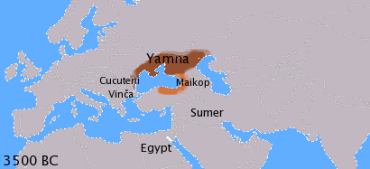
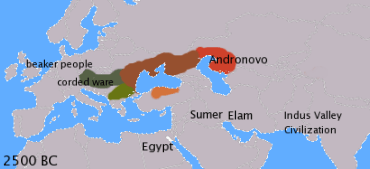
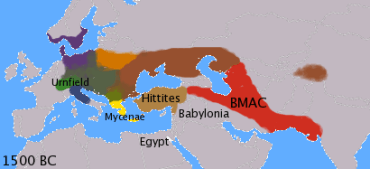

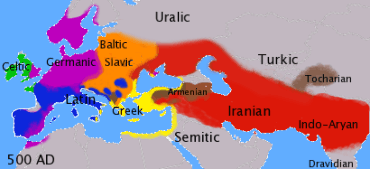
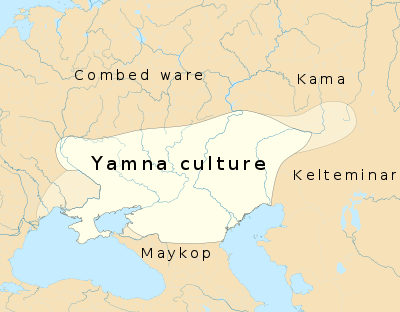
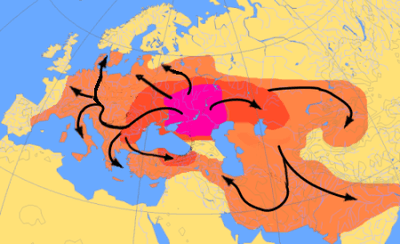


.png)
